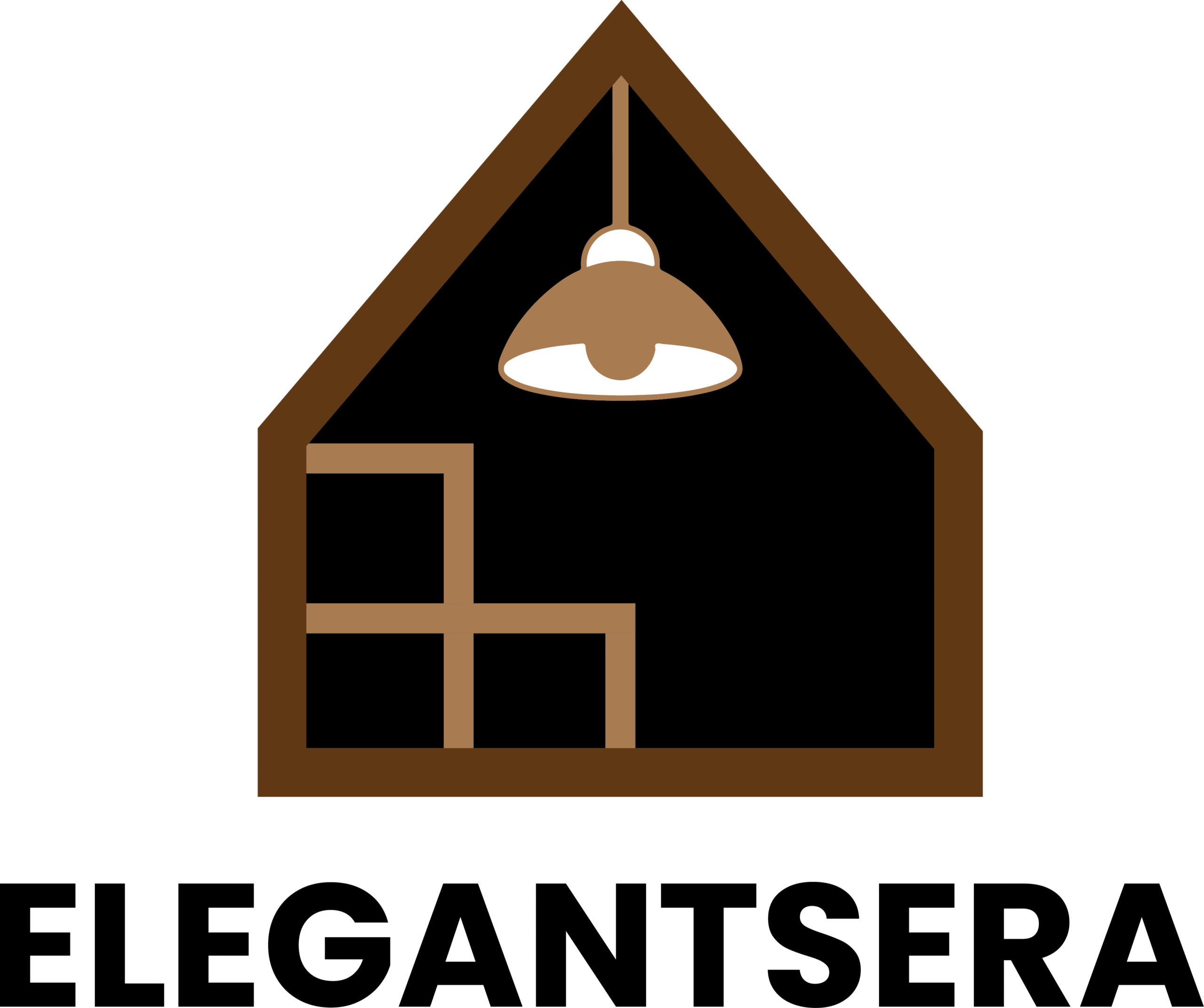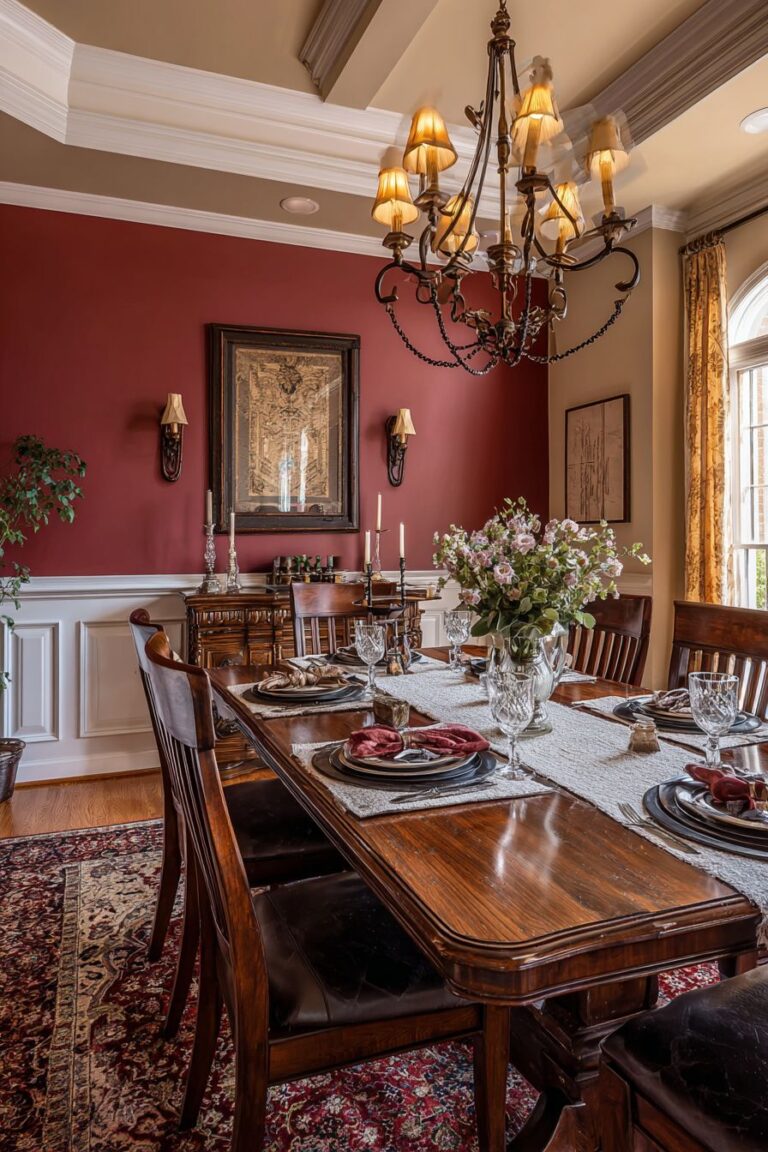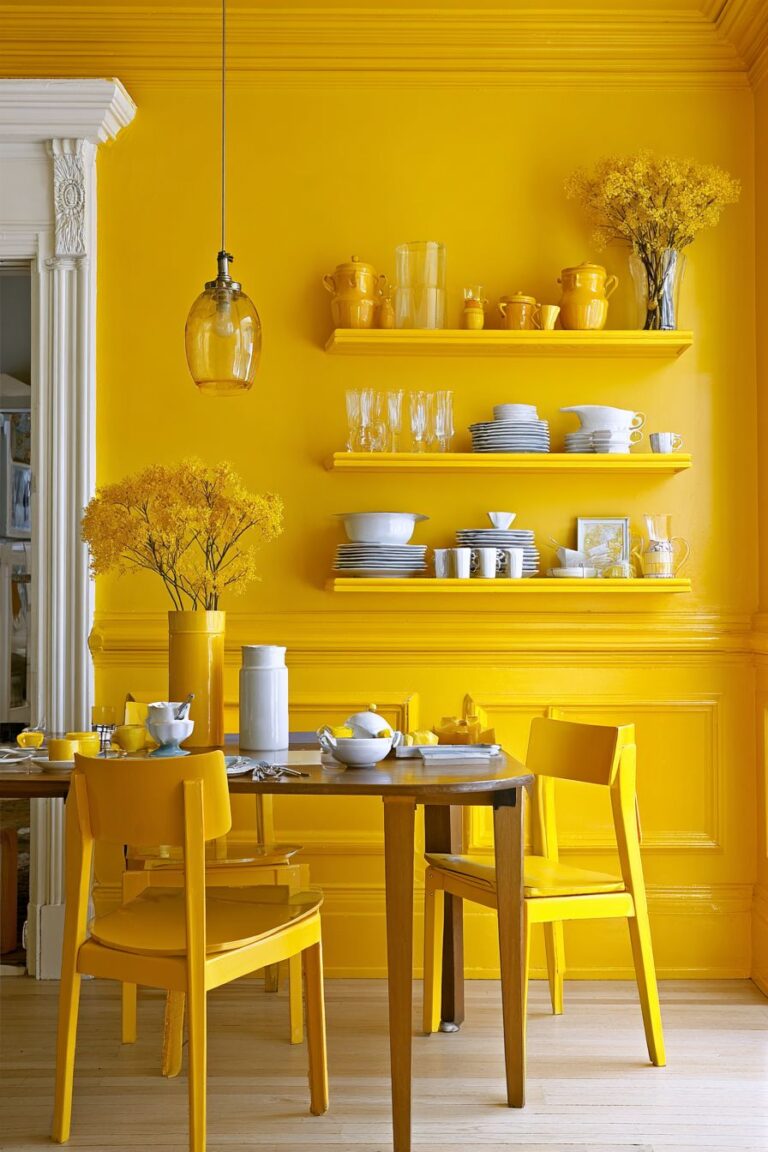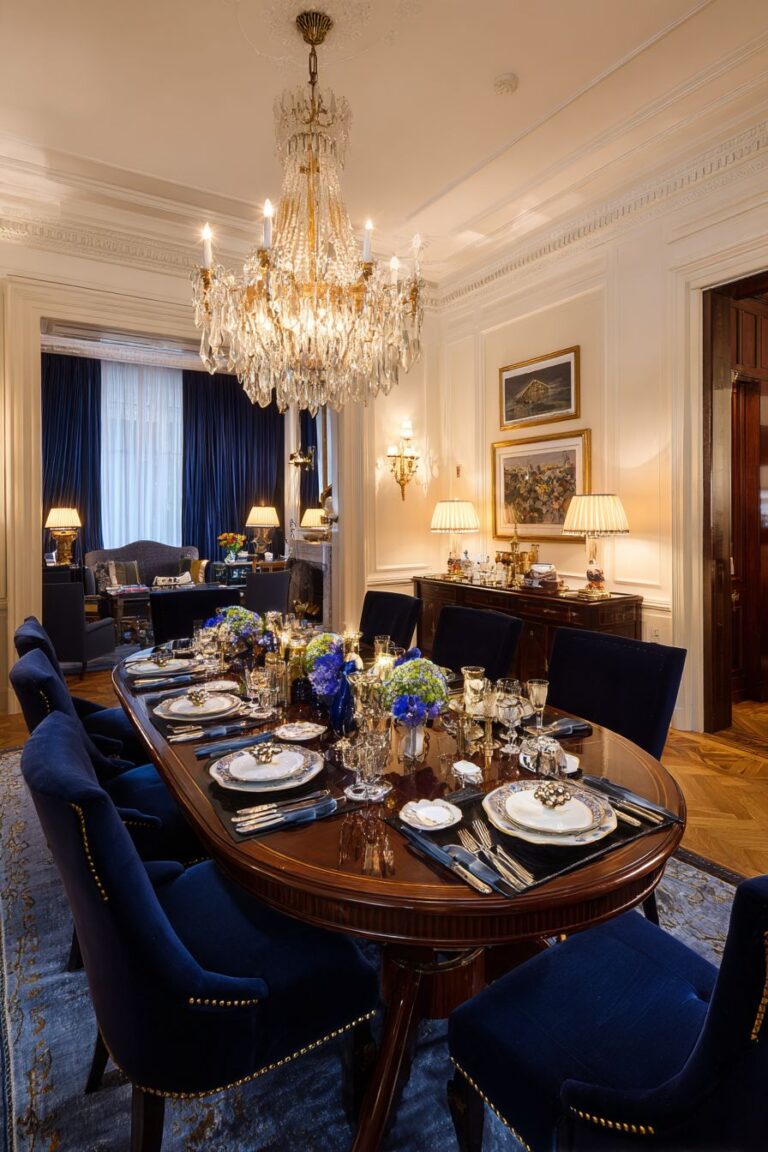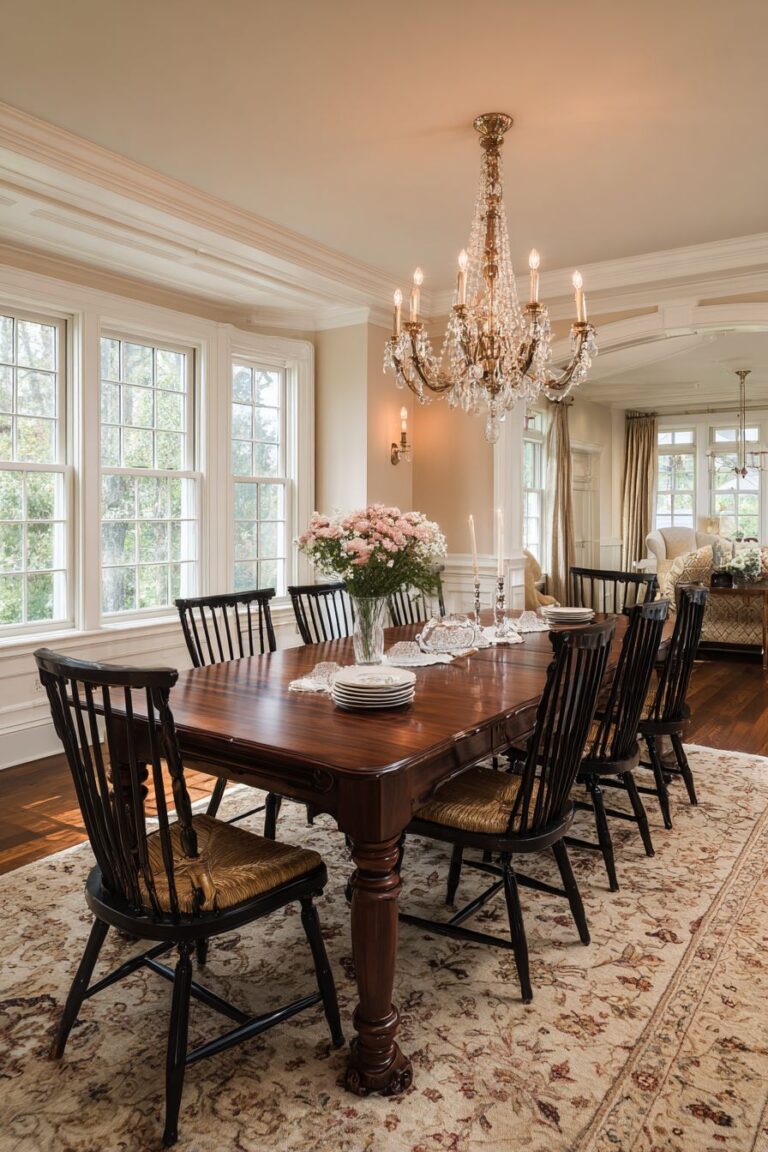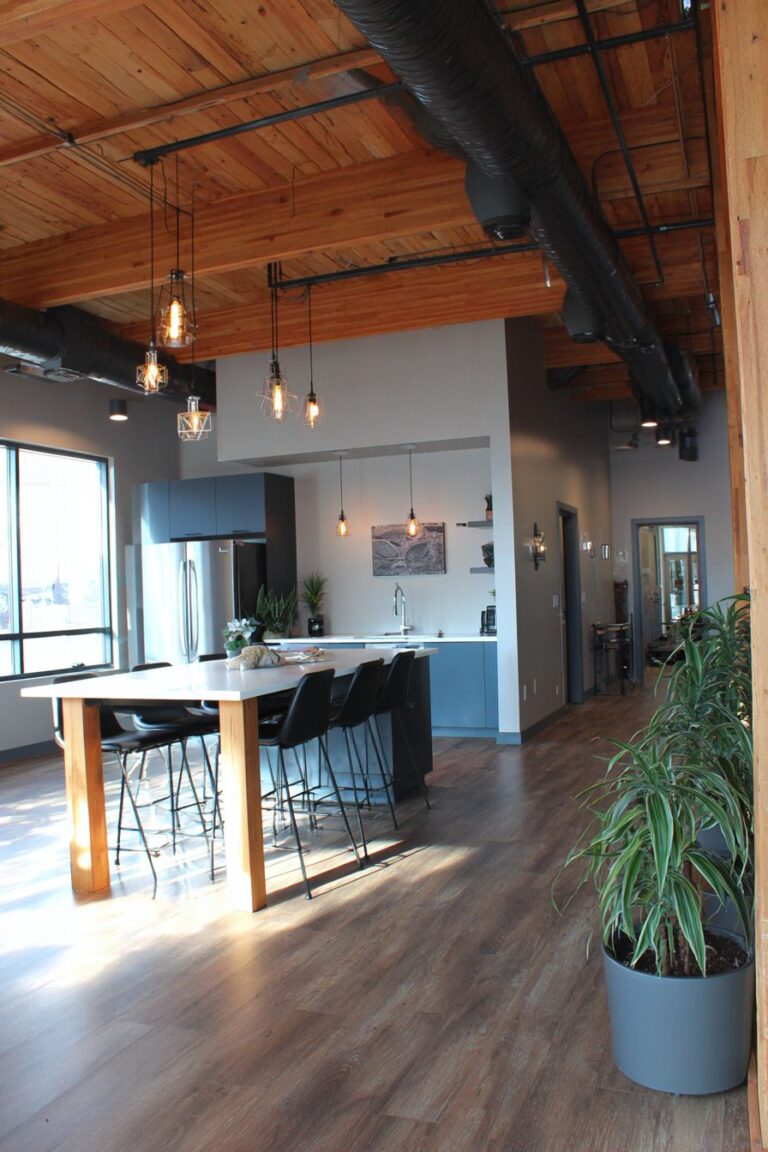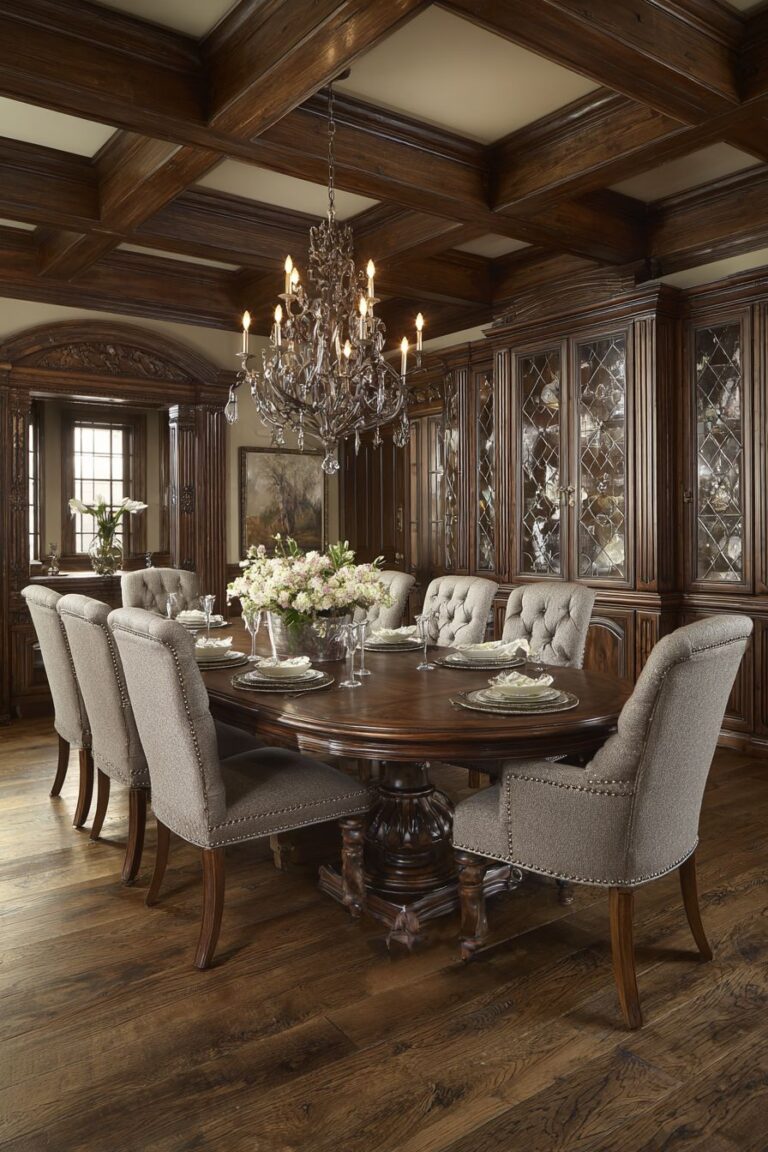Farmhouse Dining Room Ideas: Creating Timeless Spaces for Family Gatherings
The heart of every home lies in its dining room, where families gather to share meals, create memories, and strengthen bonds. In our fast-paced modern world, the farmhouse dining room style has emerged as a beloved design choice that celebrates authenticity, comfort, and timeless appeal. This rustic yet refined aesthetic draws inspiration from traditional agricultural homes, emphasizing natural materials, weathered finishes, and functional beauty that tells stories of generations past.
Farmhouse dining rooms represent more than just a design trend; they embody a lifestyle that values simplicity, craftsmanship, and connection to nature. These spaces masterfully blend practicality with charm, creating environments that feel both lived-in and lovingly curated. The beauty of farmhouse style lies in its ability to make everyone feel welcome, whether you’re hosting an intimate family dinner or a large holiday gathering.
This comprehensive guide explores twenty distinct farmhouse dining room concepts, each showcasing unique elements that contribute to the overall aesthetic. From reclaimed wood tables that bear the marks of time to vintage storage solutions that combine form with function, these designs demonstrate how thoughtful interior choices can transform any dining space into a warm, inviting sanctuary that celebrates the enduring appeal of farmhouse living.
1. Rustic Reclaimed Wood Centerpiece
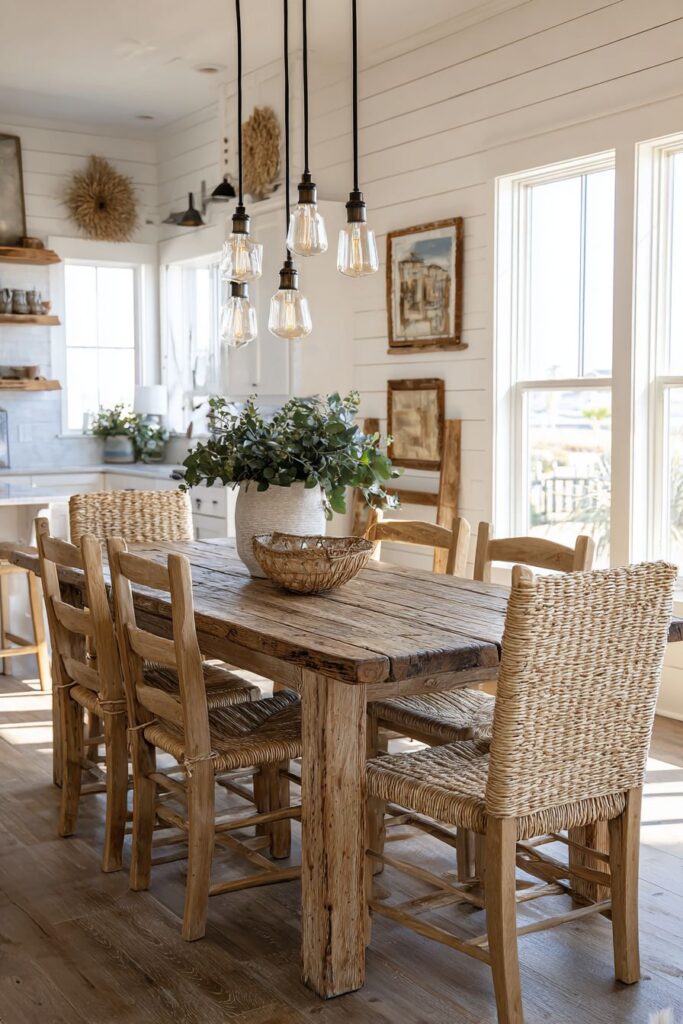
The foundation of authentic farmhouse dining begins with a substantial reclaimed wood table that serves as both functional furniture and conversation starter. This design concept celebrates the natural beauty of aged timber, where each scratch, dent, and grain pattern tells a unique story. The large dining table, crafted from salvaged barn wood or reclaimed planks, becomes the commanding focal point that anchors the entire room with its substantial presence and rich patina developed over decades of use.
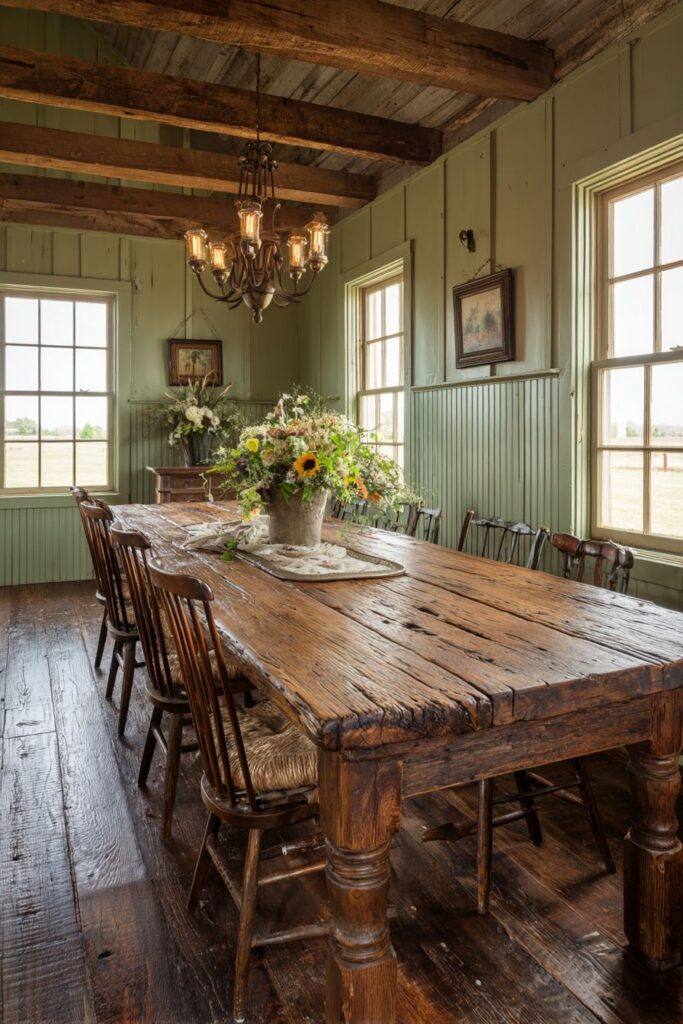
Surrounding this magnificent table, ladder-back wooden chairs with woven rush seats provide comfortable seating that maintains the room’s authentic agricultural heritage. The natural materials create a harmonious palette where wood tones range from honey amber to deep chestnut, all unified by the honest beauty of time-worn surfaces. White shiplap wainscoting extends halfway up the walls, creating visual interest while protecting surfaces from daily wear, topped with sage green paint that evokes the tranquil colors of pastoral landscapes.

The lighting design centers around a vintage chandelier fitted with Edison bulbs, casting warm, amber light that enhances the natural wood tones and creates an intimate atmosphere perfect for evening meals. This carefully chosen fixture bridges the gap between rustic charm and functional illumination, while wide plank flooring and natural fiber rugs complete the foundation of this timeless design approach.
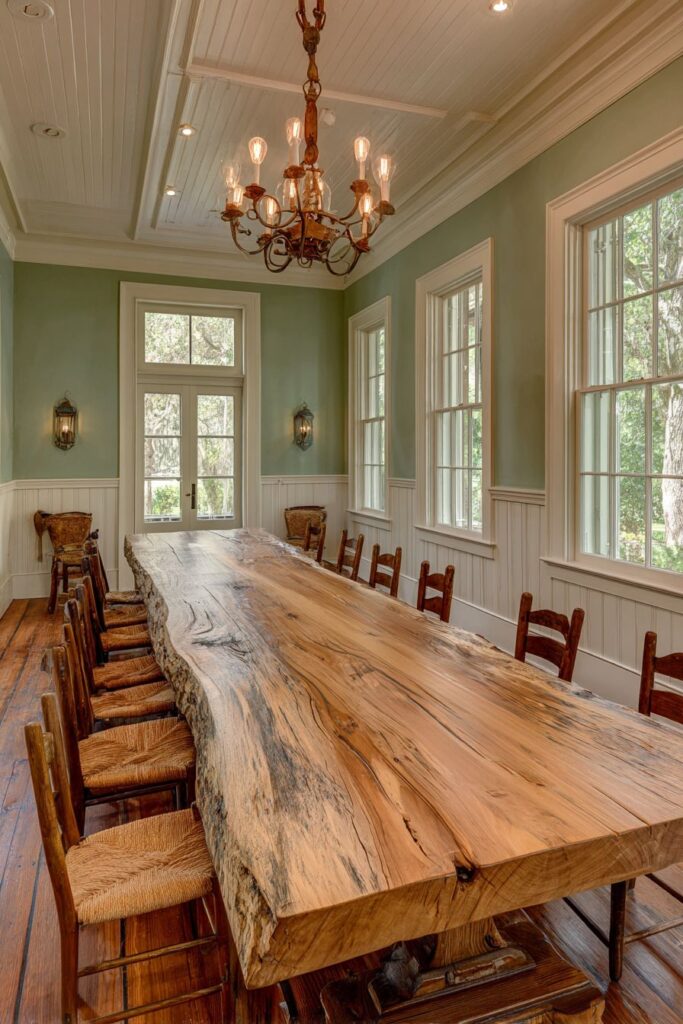
Key Design Tips:
- Select reclaimed wood with visible grain patterns and natural edge details for maximum character
- Mix chair styles slightly while maintaining the same wood tone family for collected-over-time authenticity
- Position the chandelier 30-36 inches above the table surface for optimal lighting and visual proportion
- Use sage green or similar muted colors that complement rather than compete with natural wood tones
- Incorporate rush or natural fiber seating materials to maintain the organic texture story
2. Cozy Corner Banquette Haven
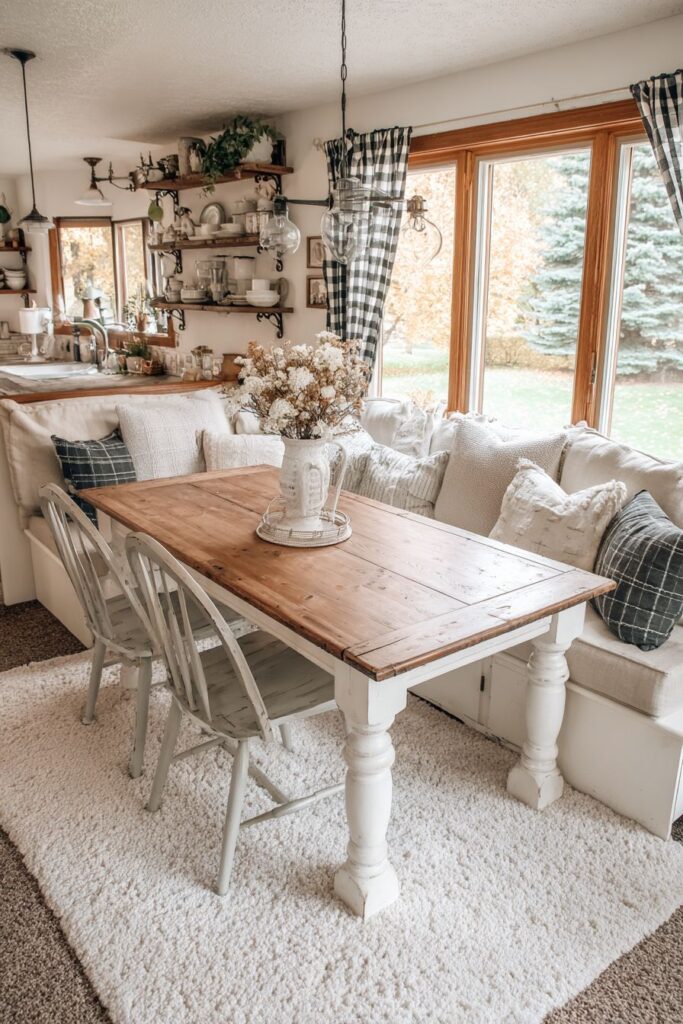
Transform your dining space into an intimate gathering spot with built-in corner bench seating that maximizes both comfort and functionality. This design approach creates a cozy nook feeling that encourages lingering conversations over meals, while the weathered oak farmhouse table with turned legs provides the perfect complement to the upholstered seating arrangement. Cream-colored cushions soften the wooden framework, while plaid throw pillows add traditional farmhouse pattern and seasonal color flexibility.
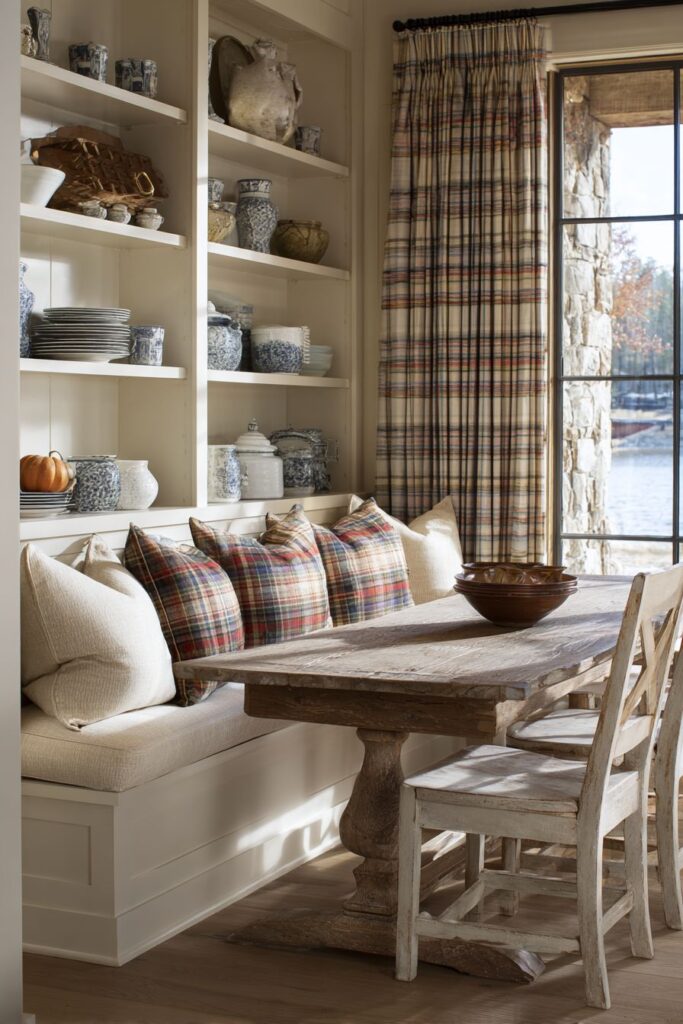
The magic of this design lies in its ability to accommodate more people in a smaller footprint while creating an incredibly welcoming atmosphere. Mismatched vintage wooden chairs painted in soft white complete the seating arrangement, allowing for flexible dining configurations while maintaining the collected-over-time aesthetic that defines authentic farmhouse style. The weathered finish on the table shows gentle wear patterns that suggest years of family meals and celebrations.
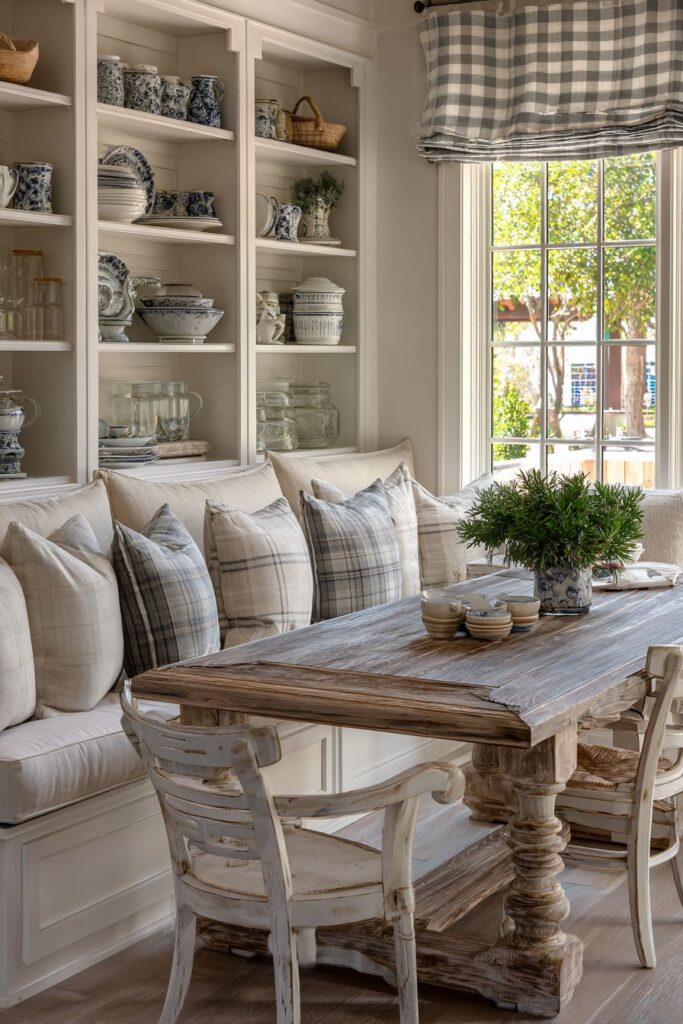
Open shelving displays become both functional storage and decorative elements, showcasing ceramic dishes, mason jar collections, and everyday items that contribute to the lived-in charm. Natural daylight streaming through gingham-curtained windows illuminates the space with soft, diffused light that highlights textures and creates gentle shadows that emphasize the cozy, intimate scale of this dining arrangement.
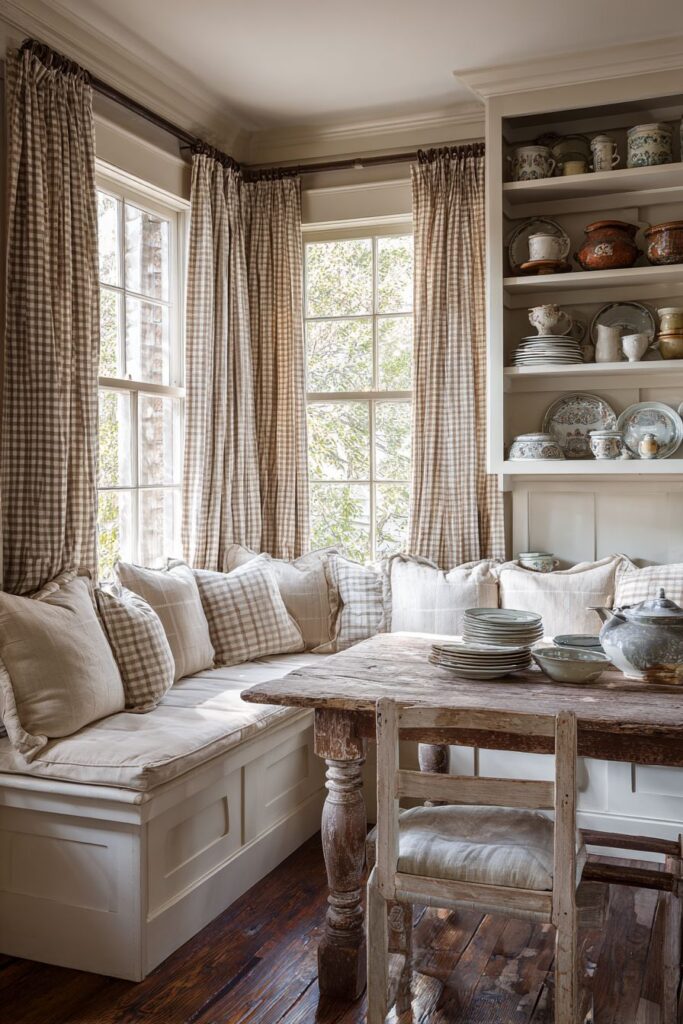
Key Design Tips:
- Build banquette seating with hidden storage underneath for linens and seasonal items
- Choose durable, washable fabrics for cushions that can withstand daily family use
- Mix painted and natural wood finishes to create visual interest without overwhelming the space
- Display everyday dishes on open shelves to maintain the functional, unfussy farmhouse aesthetic
- Use gingham or similar traditional patterns sparingly as accent elements rather than dominant features
3. Antique Hutch Storage Showcase
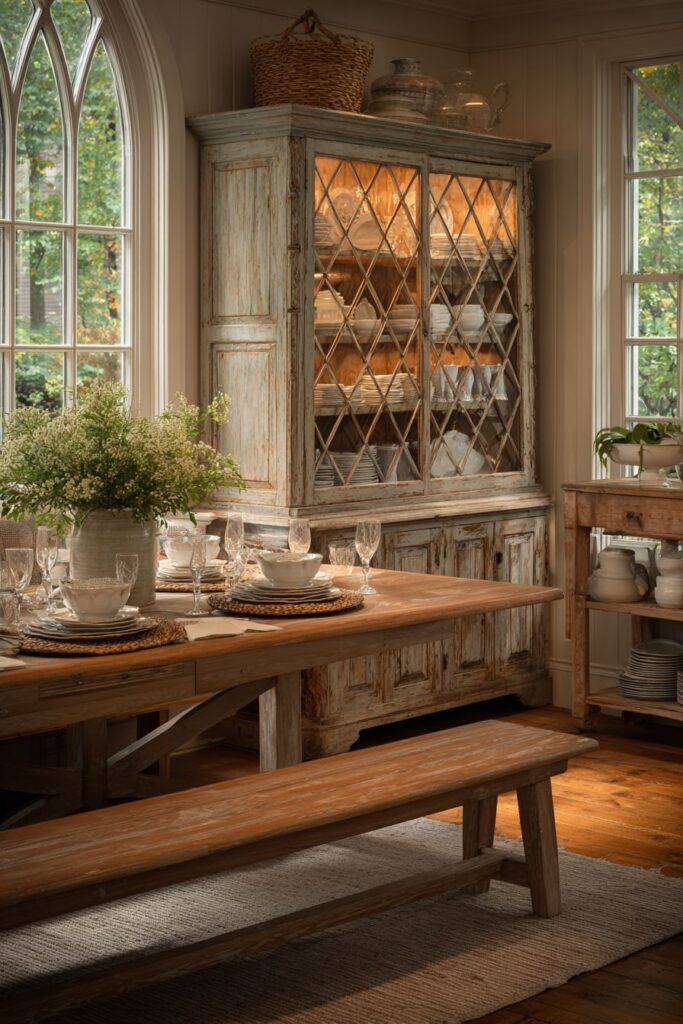
The farmhouse dining room reaches its full potential when storage becomes a design feature that celebrates both practicality and beauty. A large antique hutch with chicken wire door inserts serves as the room’s storage centerpiece, displaying white ironstone dishes and vintage glassware while keeping everyday items organized and accessible. The weathered pine cabinet, with its distressed paint finish and authentic aging, tells the story of generations of family meals and seasonal celebrations.

This storage-focused design approach demonstrates how functional elements can become the room’s most striking visual features. The hutch’s generous proportions provide ample space for seasonal dish rotations, serving pieces, and treasured family heirlooms, while chicken wire inserts offer dust protection with vintage charm. The weathered finish reveals layers of paint and natural wood, creating depth and visual interest that can only be achieved through authentic aging or expert distressing techniques.
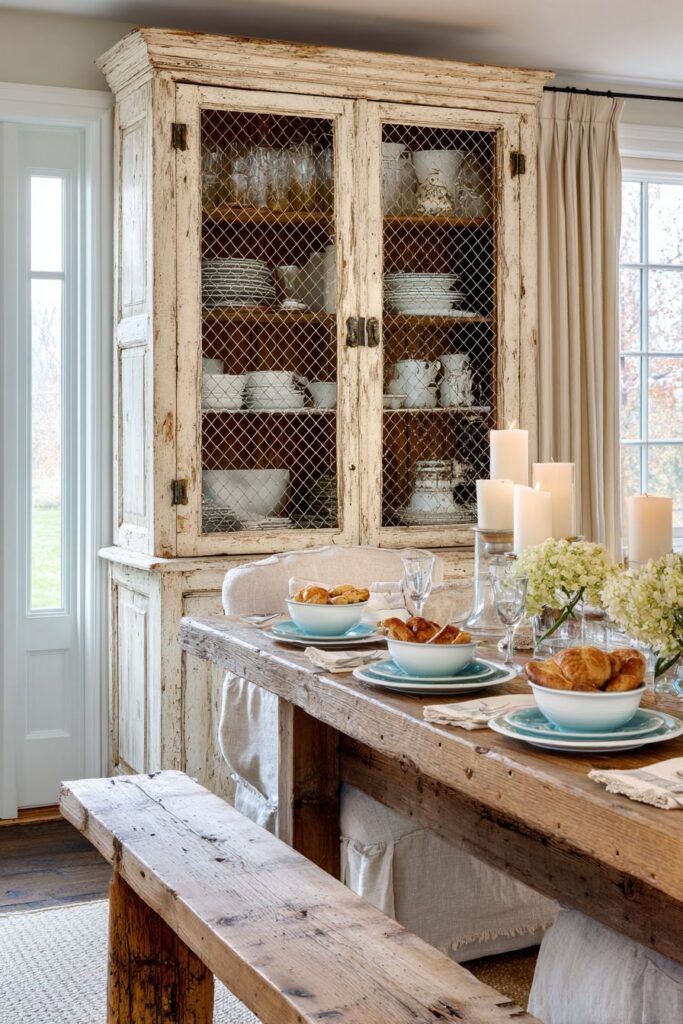
A long farmhouse table with bench seating creates a practical dining arrangement that complements the hutch’s substantial presence without competing for attention. The bench seating tucks neatly under the table when not in use, maintaining clean lines while providing flexible seating options for varying group sizes. This combination of storage and seating creates a highly functional space that maintains the uncluttered, organized aesthetic that defines successful farmhouse design.
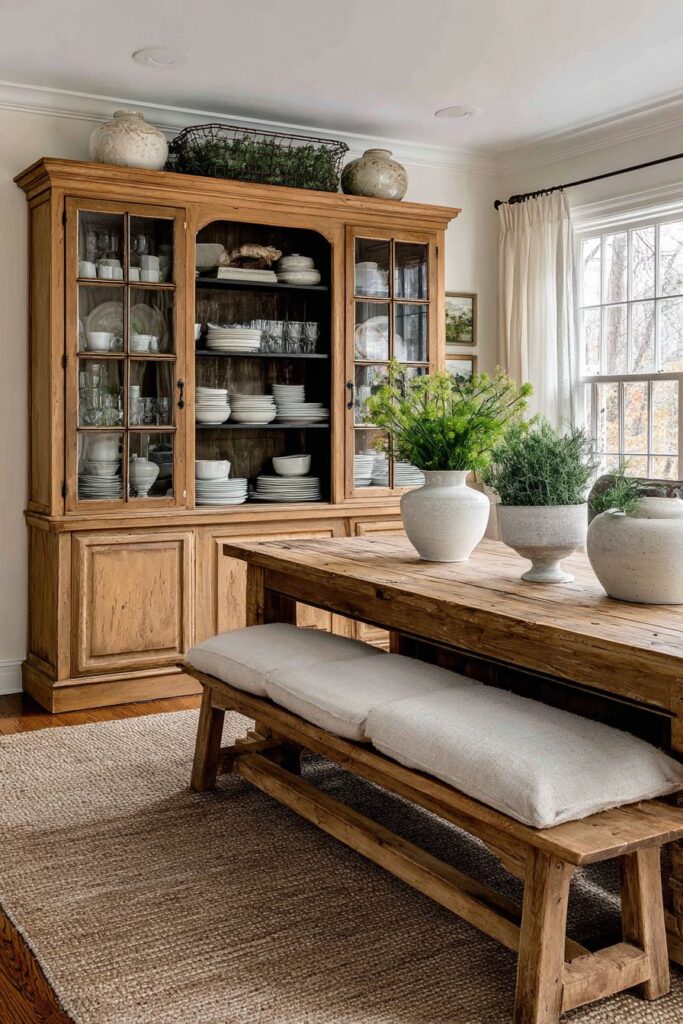
Key Design Tips:
- Choose storage pieces with both open and closed sections to balance display and concealment needs
- Display collections of similar items, like white ironstone, for cohesive visual impact
- Ensure hutch proportions match your room size – oversized pieces work best in generous spaces
- Position storage pieces away from high-traffic areas to prevent damage and maintain functionality
- Use chicken wire or similar materials that provide visibility while protecting displayed items from dust
4. Bright Exposed Beam Architecture

Architectural elements define the character of farmhouse dining rooms, and exposed wooden ceiling beams create dramatic visual impact while honoring traditional construction methods. White-painted brick walls provide a clean backdrop that allows the natural wood elements to take center stage, while the massive reclaimed barn wood table serves as the room’s anchor point. This design approach celebrates the structural bones of the space, transforming functional elements into decorative features.

The generous proportions of this bright, airy space allow for substantial furniture pieces without feeling cramped or overwhelming. Windsor-style chairs surround the commanding table, their traditional profiles and authentic construction methods reinforcing the room’s connection to historical craftsmanship. The painted brick walls reflect natural light throughout the space, creating an bright, welcoming environment that feels both grand and intimate.

Galvanized metal light fixtures provide industrial farmhouse contrast that bridges traditional and contemporary sensibilities. These utilitarian fixtures honor the agricultural roots of farmhouse style while providing excellent task lighting for family meals and activities. Natural light filters through white cotton curtains, creating gentle shadows that emphasize the rustic textures and architectural details while maintaining privacy and light control.

Key Design Tips:
- Paint brick walls in bright white to maximize light reflection and create visual unity
- Choose exposed beam treatments that match your home’s actual construction period for authenticity
- Size your dining table proportionally to your room – massive spaces can accommodate substantial furniture
- Use industrial-style lighting to add contemporary functionality to traditional architectural elements
- Install window treatments that filter light while maintaining the room’s bright, airy character
5. Round Pedestal Charm
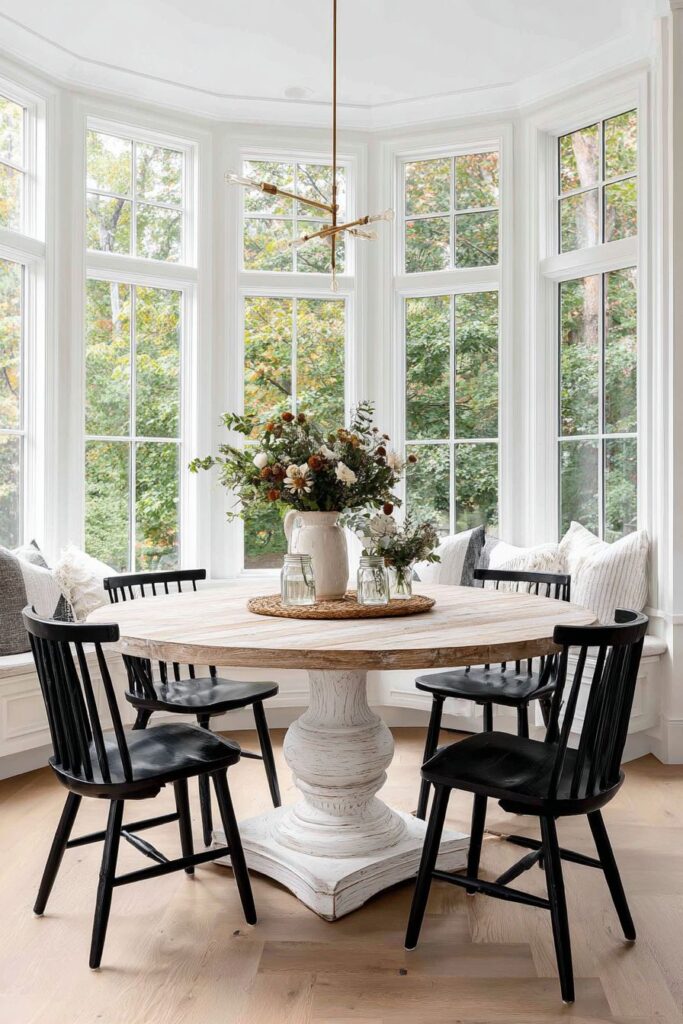
The round pedestal dining table represents one of farmhouse design’s most versatile and space-efficient solutions, creating intimate dining experiences while accommodating flexible seating arrangements. This design concept features a distressed white base paired with a natural wood top, demonstrating the classic farmhouse combination of painted and natural finishes that creates visual interest without overwhelming the space. The circular shape encourages conversation and creates a sense of equality among diners that linear tables cannot achieve.
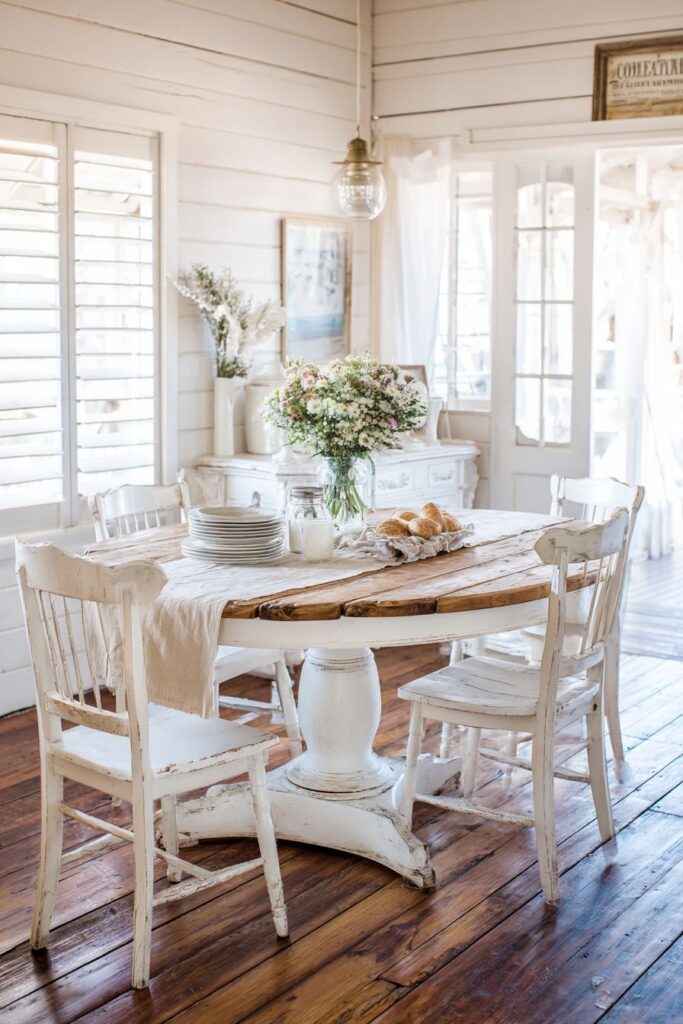
Spindle-back chairs in various stages of chippy paint create the authentic collected-over-time appearance that defines genuine farmhouse style. Each chair tells its own story through unique wear patterns and paint variations, suggesting pieces gathered from different sources over many years rather than purchased as a matching set. This approach requires careful curation to maintain harmony while celebrating individuality, creating a dining arrangement that feels both cohesive and authentically eclectic.

A vintage grain sack runner adds textural interest and practical surface protection while honoring the agricultural roots of farmhouse style. Mason jar centerpieces filled with fresh wildflowers provide seasonal color and natural beauty that changes throughout the year, creating a dynamic focal point that celebrates the connection between indoor and outdoor living that defines farmhouse philosophy.
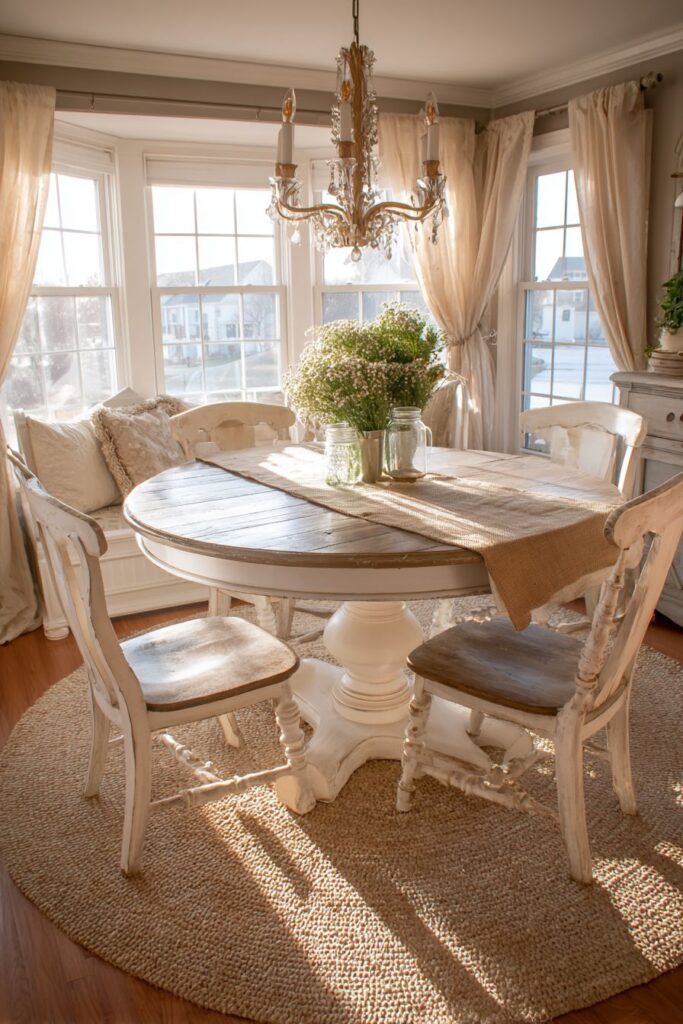
Key Design Tips:
- Choose pedestal bases that provide adequate support for your table size and daily use requirements
- Vary chair paint finishes subtly while maintaining the same basic color family for unity
- Use grain sack or similar textiles that reference agricultural heritage in table runners and accessories
- Select wildflowers or garden flowers over formal arrangements to maintain casual, natural aesthetics
- Position round tables to allow easy movement around all sides for optimal functionality
6. Compact Space Solutions
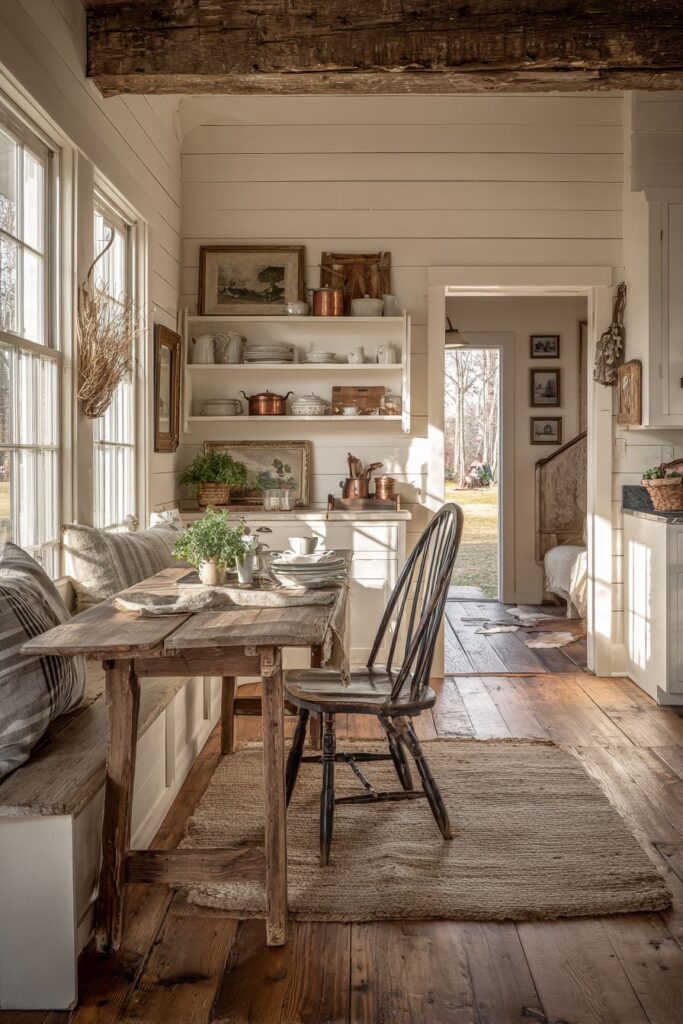
Small farmhouse dining rooms require thoughtful planning to maximize both function and style without sacrificing the authentic charm that defines the aesthetic. A drop-leaf farm table positioned against shiplap walls painted in warm cream provides flexible dining surface that expands when needed while maintaining a compact footprint for daily use. This space-saving approach demonstrates how farmhouse style adapts to modern living requirements while maintaining its essential character and appeal.
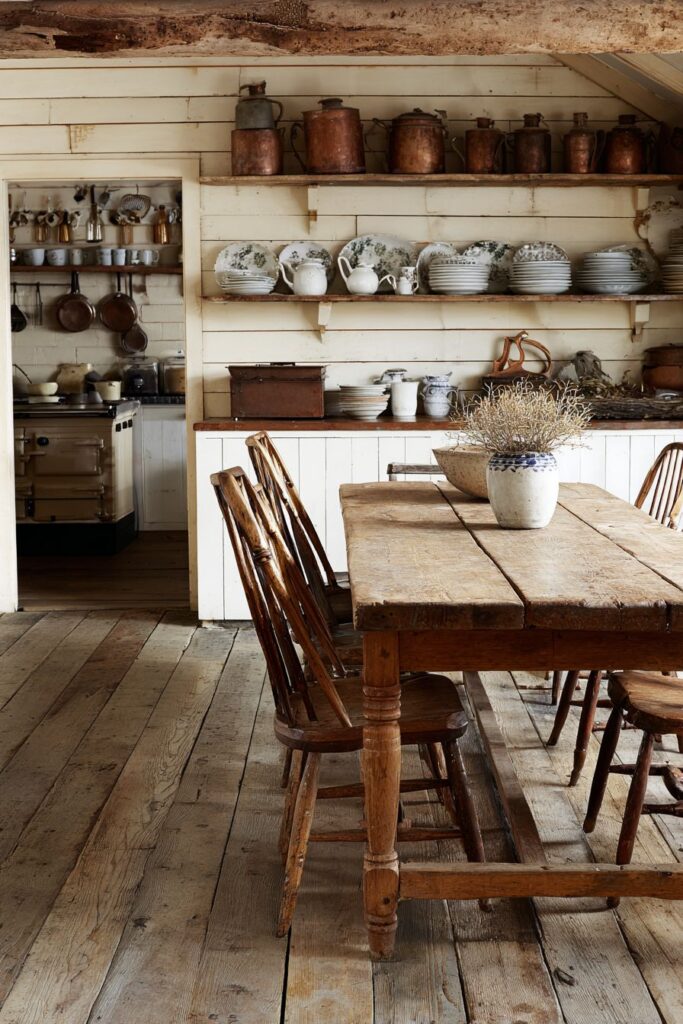
Two Windsor chairs and a rustic wooden bench provide flexible seating options that accommodate varying numbers of diners while tucking neatly away when not needed. The bench serves double duty as extra seating and casual surface for serving dishes or decorative elements, maximizing functionality in the limited space. Open shelving displays vintage crockery and copper pots, creating storage solutions that become decorative elements while keeping essential items accessible.
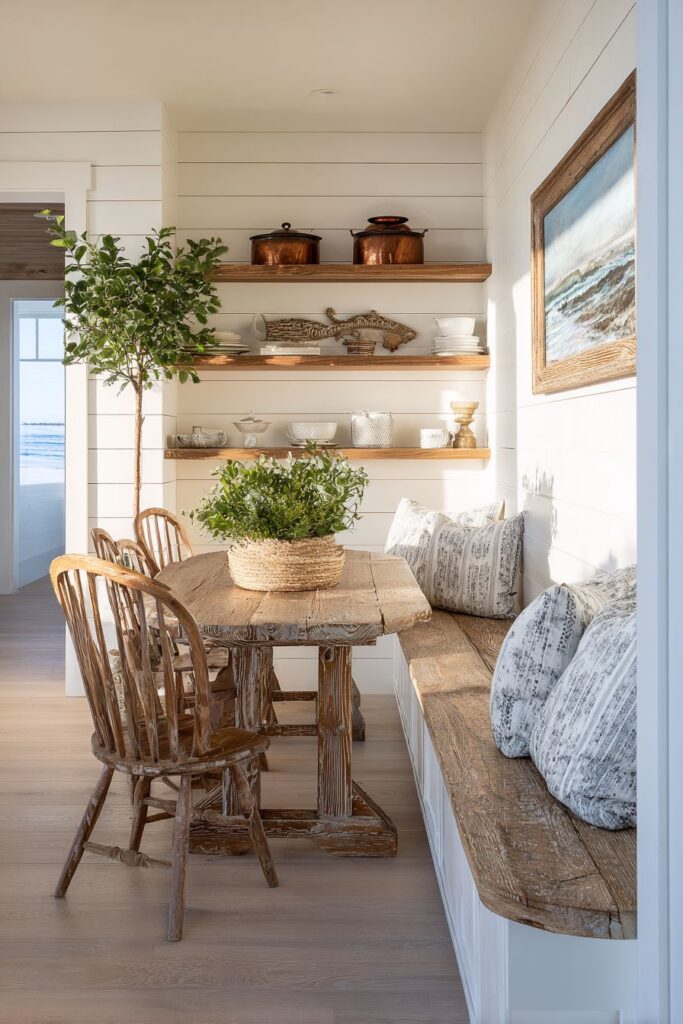
The intimate scale of this design approach creates a cozy, welcoming atmosphere that makes even simple meals feel special and intentional. Soft natural lighting emphasizes the authentic farmhouse materials and weathered wood textures throughout the space, while careful attention to proportion ensures that every element serves both practical and aesthetic purposes without overwhelming the compact dimensions.
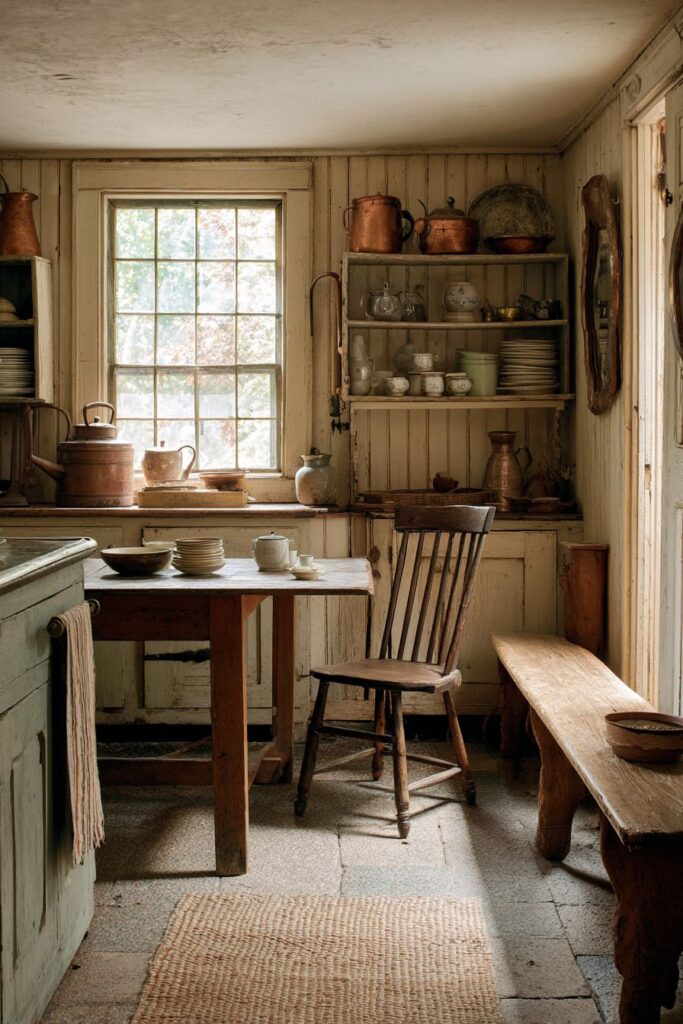
Key Design Tips:
- Choose drop-leaf or expandable tables that adapt to your actual dining needs rather than maximum capacity
- Use benches and stools that tuck completely under tables to maximize floor space
- Install open shelving at varying heights to create visual interest while providing essential storage
- Paint walls in light, warm colors that reflect natural light and make small spaces feel larger
- Select multi-functional pieces that serve storage, seating, and display purposes simultaneously
7. Trestle Table Tradition
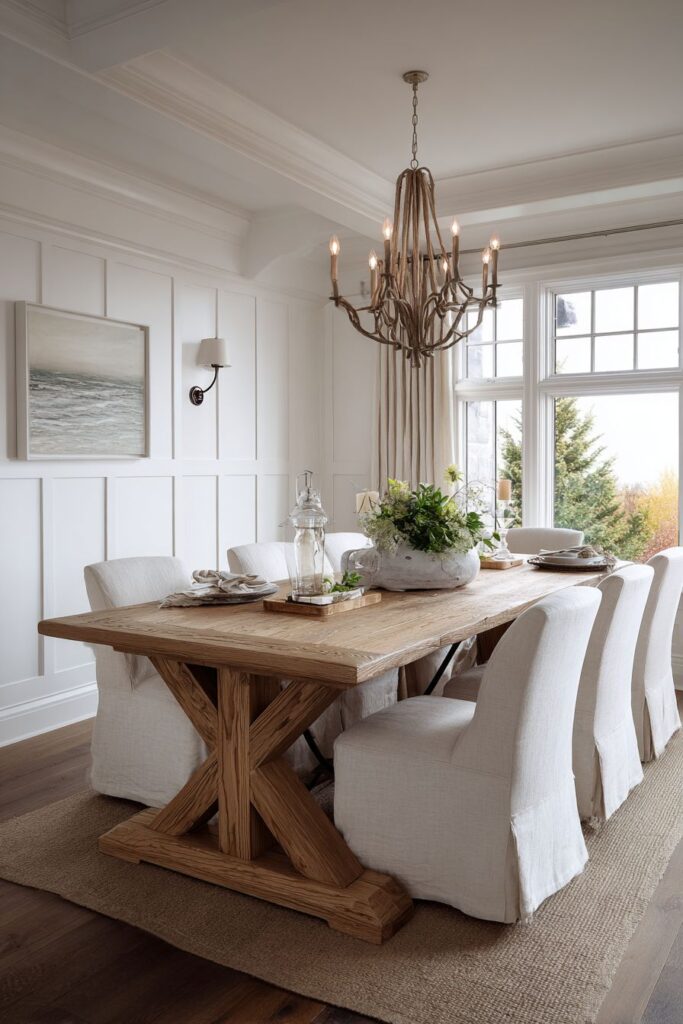
The trestle-style dining table represents one of the most enduring forms in farmhouse furniture, combining substantial construction with timeless design that has served families for centuries. This concept features a thick planked top supported by a substantial X-frame base crafted in natural oak, showcasing the honest joinery and solid construction that defines authentic farmhouse craftsmanship. The visible structural elements become decorative features that celebrate rather than hide the table’s construction methods.
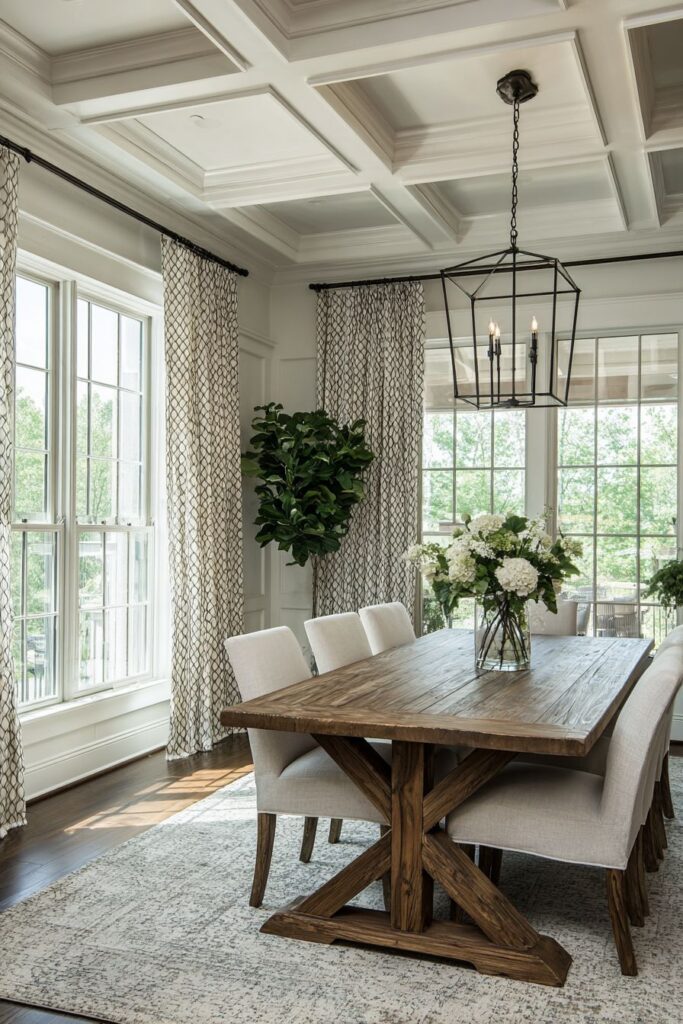
Upholstered parsons chairs in natural linen complement the rustic table while maintaining comfort standards expected in contemporary dining. This thoughtful combination demonstrates how farmhouse style successfully integrates comfort with authenticity, creating dining experiences that honor tradition while meeting modern needs. The clean lines of the parsons chairs provide visual balance to the table’s substantial presence without competing for attention.
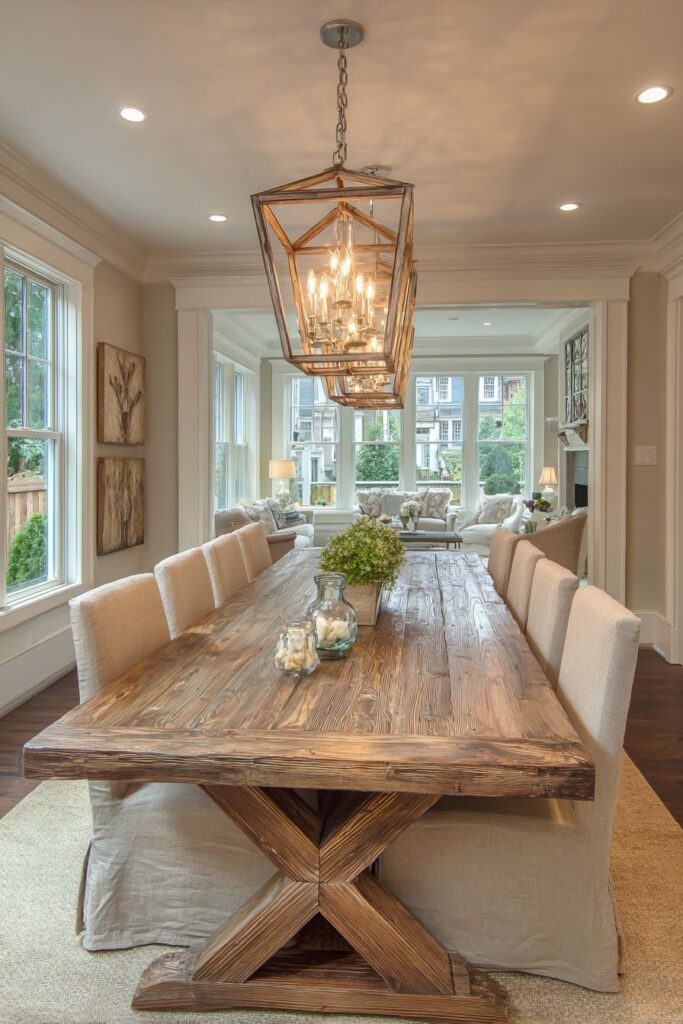
White beadboard wainscoting extends around the room, creating classic farmhouse wall treatment that protects surfaces while adding architectural interest and texture. The painted beadboard topped with neutral wall color creates a balanced backdrop that allows furniture pieces to take center stage while contributing to the room’s overall sense of craftsmanship and attention to detail that defines successful farmhouse design.
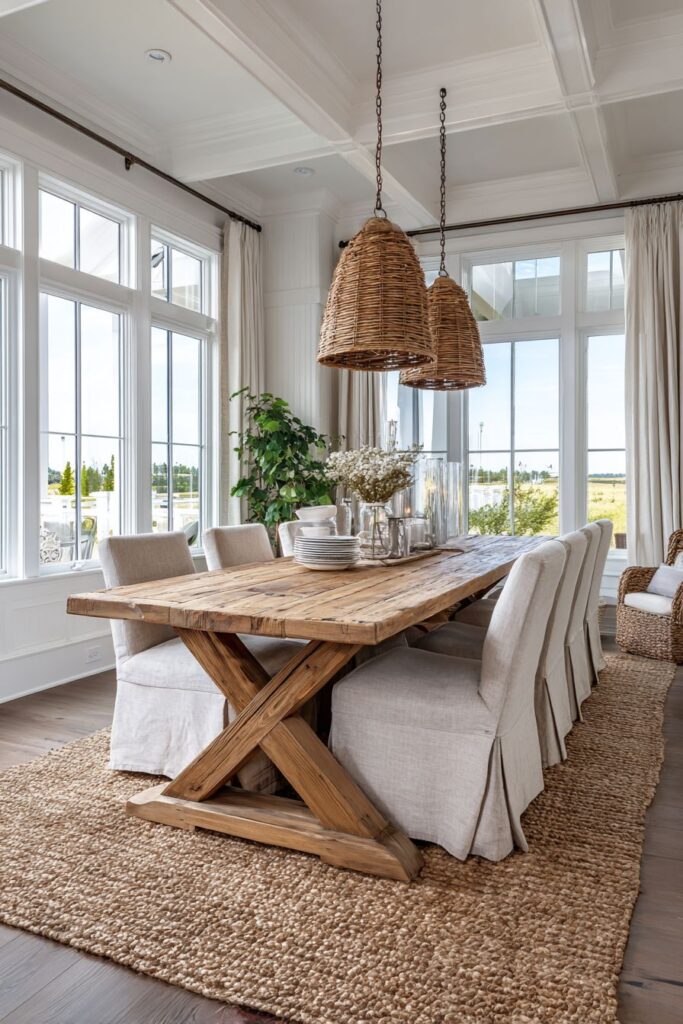
Key Design Tips:
- Select trestle tables with visible joinery details that showcase traditional woodworking methods
- Balance rustic tables with comfortable upholstered seating for extended dining comfort
- Use beadboard wainscoting to add authentic farmhouse architectural detail while protecting wall surfaces
- Choose neutral colors that allow natural wood tones and textures to remain the dominant design elements
- Ensure adequate clearance around trestle bases to prevent interference with chair placement and movement
8. Harvest Table Gatherings
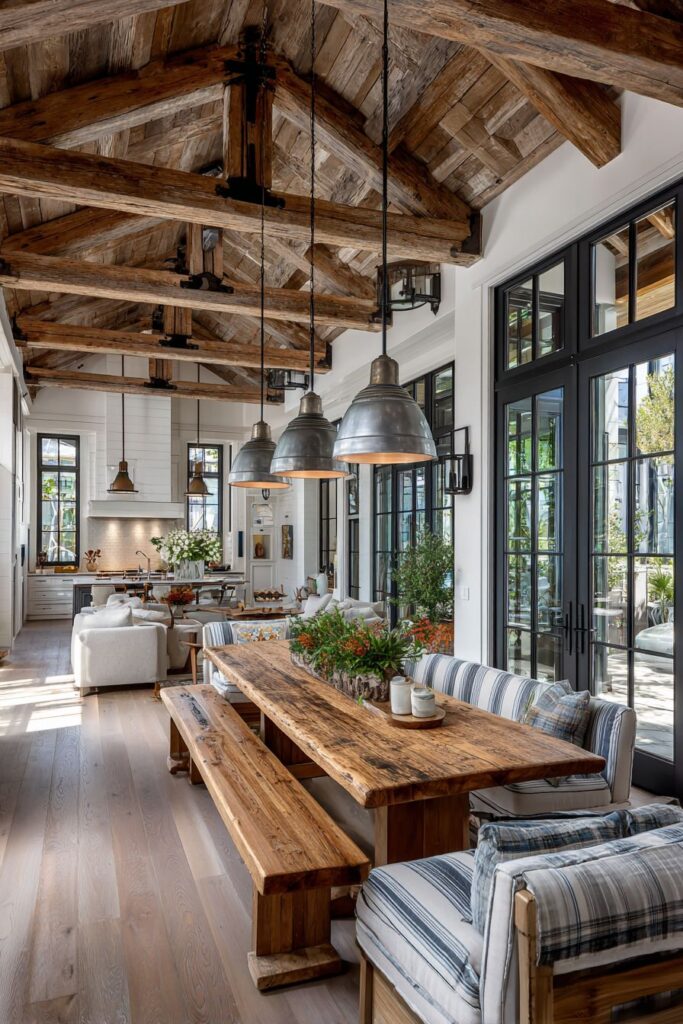
The harvest table concept celebrates the farmhouse tradition of large family gatherings and community meals, featuring long tables with benches on both sides that accommodate generous numbers of diners. This design approach prioritizes function and hospitality over formal dining conventions, creating an atmosphere where everyone feels welcome and included. The natural wood patina shows subtle wear marks that tell stories of countless shared meals and family celebrations.
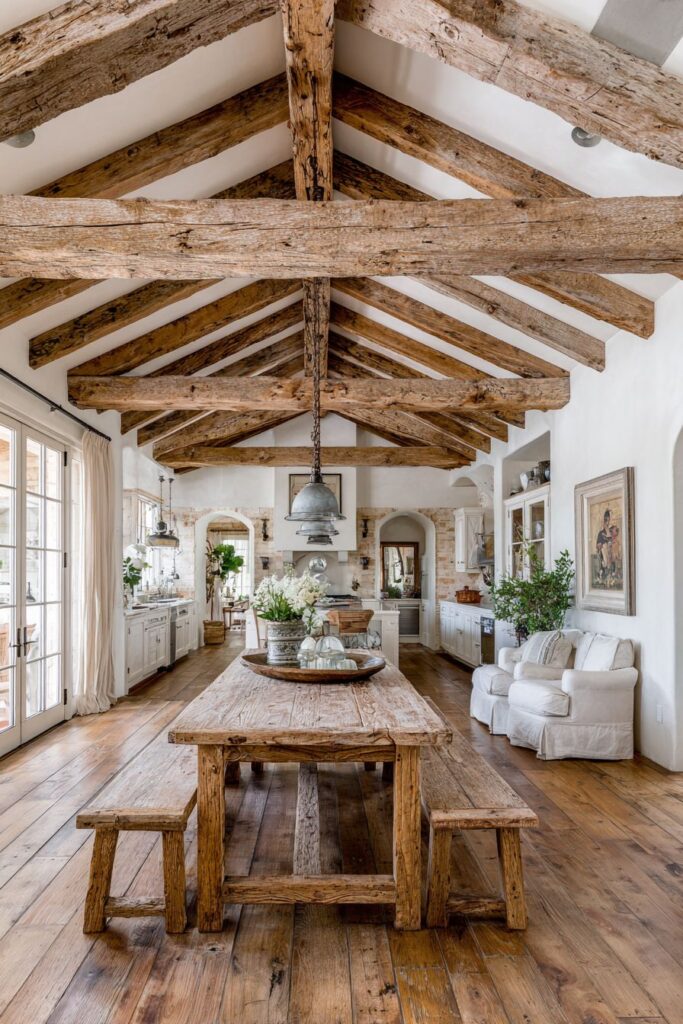
Pendant lights with galvanized shades hang at varying heights above the table, providing task lighting while adding visual interest and industrial farmhouse character. The utilitarian fixture choices honor the agricultural roots of farmhouse style while delivering practical illumination for daily activities. This lighting approach creates intimate pools of light along the table’s length while maintaining the overall room’s welcoming atmosphere.
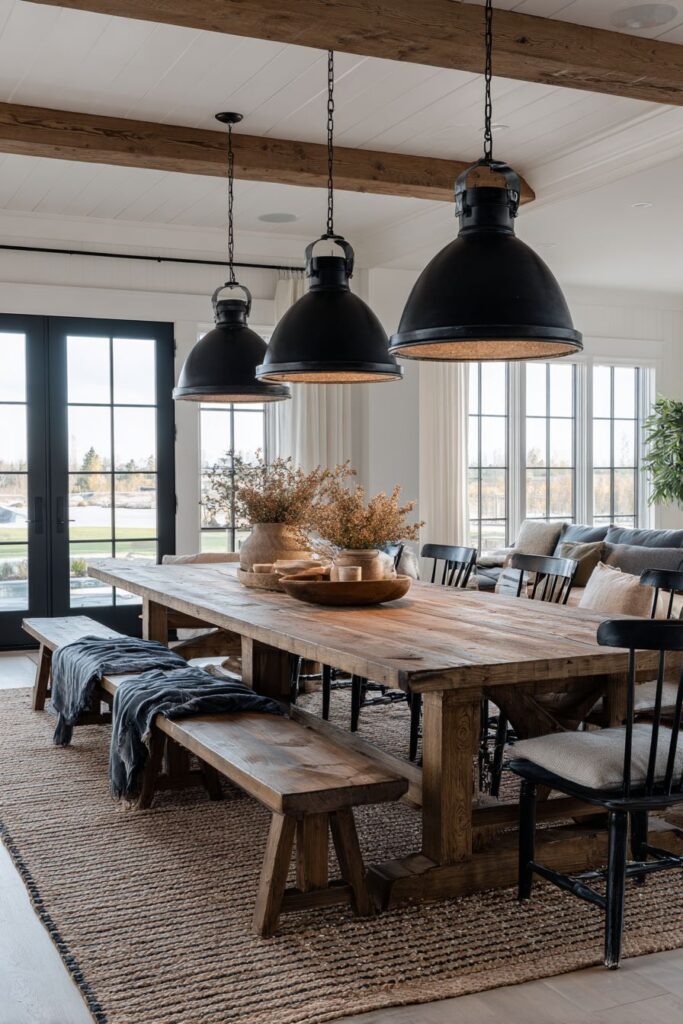
The communal seating arrangement encourages interaction and conversation, breaking down formal dining barriers and creating a sense of equality among diners. Natural lighting from French doors emphasizes the welcoming farmhouse aesthetic while connecting the dining space to outdoor living areas, reinforcing the farmhouse philosophy of seamless indoor-outdoor living that celebrates seasonal changes and natural rhythms.
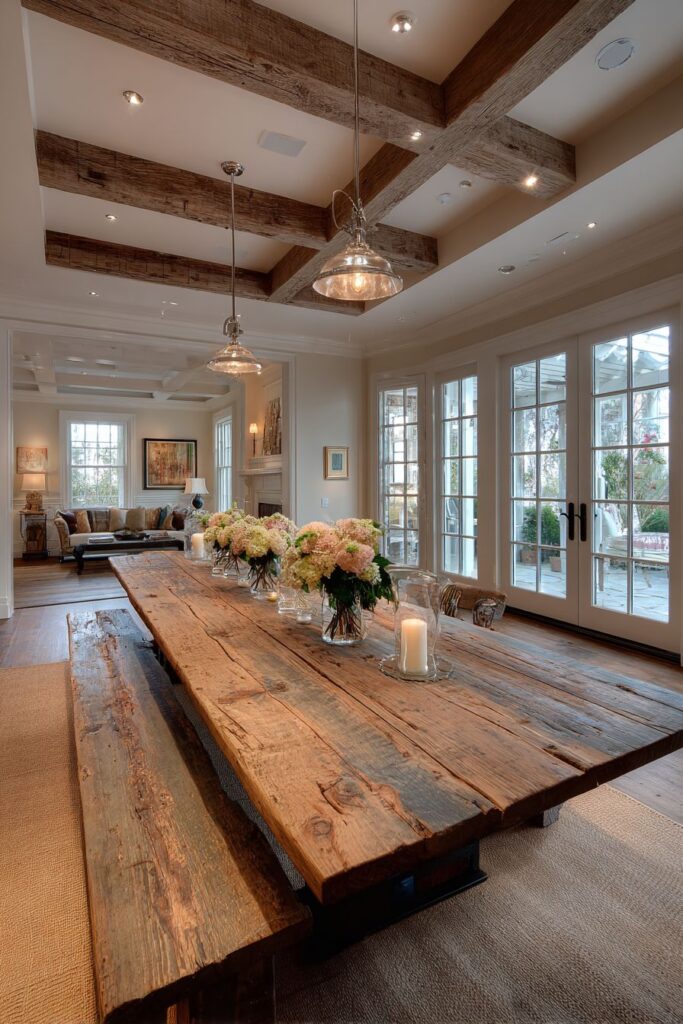
Key Design Tips:
- Size harvest tables to accommodate your typical gathering numbers plus occasional extras
- Use bench seating to maximize capacity while maintaining the casual, welcoming farmhouse atmosphere
- Install pendant lighting at varying heights to create visual rhythm and adequate task illumination
- Position tables near French doors or large windows to emphasize the indoor-outdoor connection
- Choose tables with natural patina or distressing that suggests years of family use and celebrations
9. Collected Treasures Display
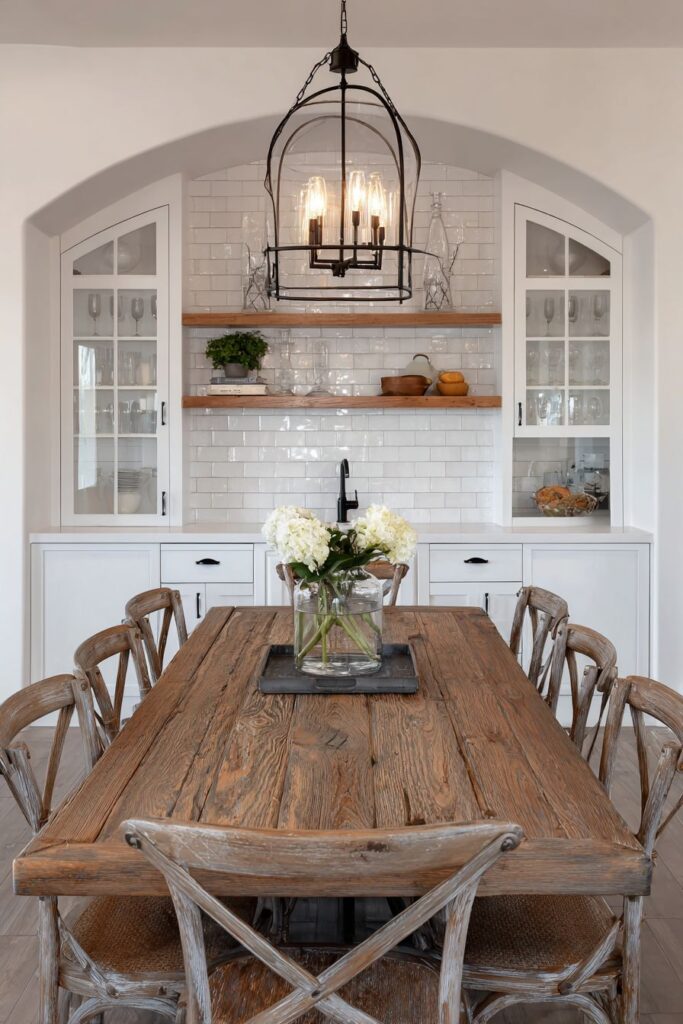
The essence of authentic farmhouse style lies in its collected-over-time aesthetic, where each piece tells a story and contributes to a narrative of family history and personal taste. This design concept features a refinished antique dining table surrounded by a carefully curated mix of vintage wooden chairs, each displaying unique character and patina that suggests discovery at different times and places. The beauty of this approach lies in the careful balance between variety and harmony.
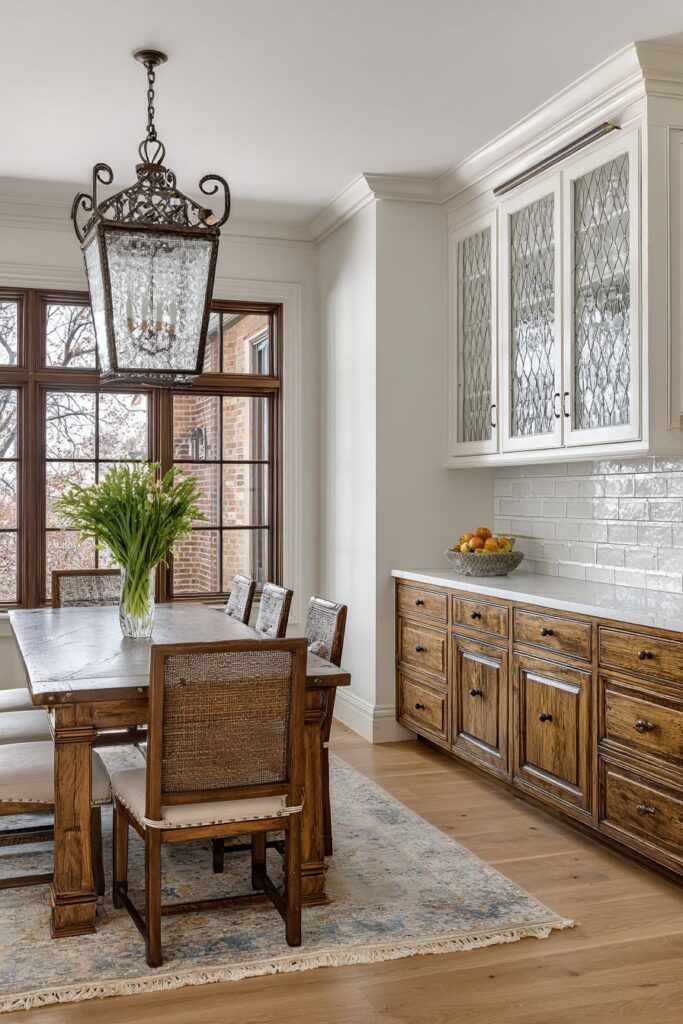
A subway tile backsplash behind a built-in serving buffet provides clean contrast to the rustic elements while maintaining the practical functionality essential to farmhouse living. The crisp, geometric pattern of subway tiles creates visual relief from the organic textures of wood and weathered finishes, demonstrating how farmhouse style successfully incorporates both rustic and refined elements within a single space.
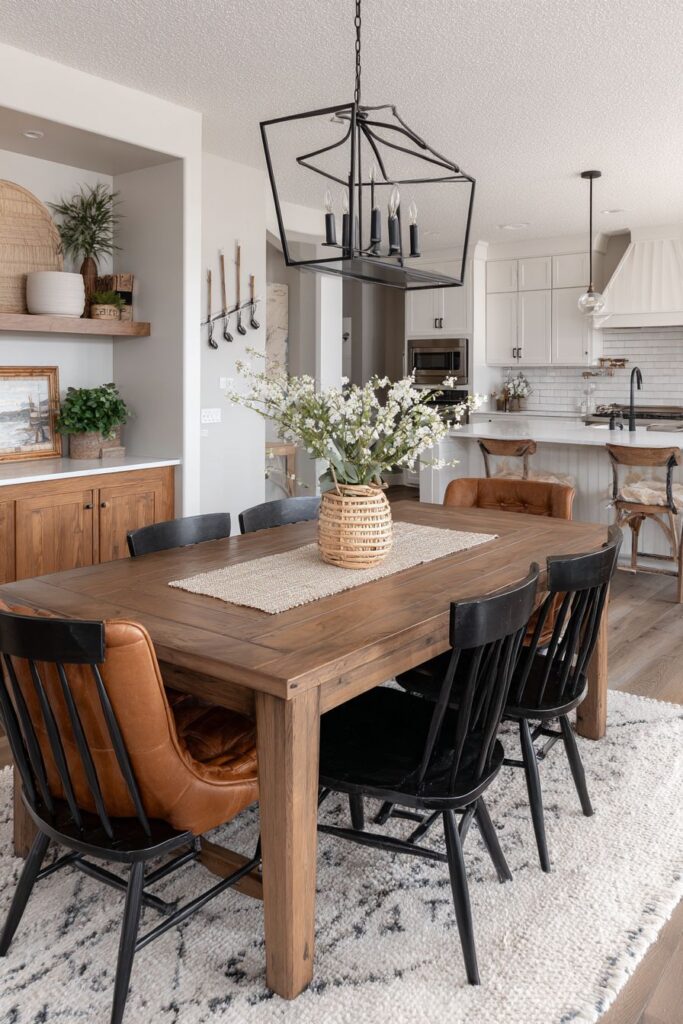
The wrought iron chandelier provides ambient lighting that enhances the collected aesthetic while contributing its own story of craftsmanship and age. Professional interior photography with soft diffused lighting showcases how different pieces work together to create a cohesive whole, proving that authentic farmhouse style rewards patience and careful curation over quick decorating solutions.
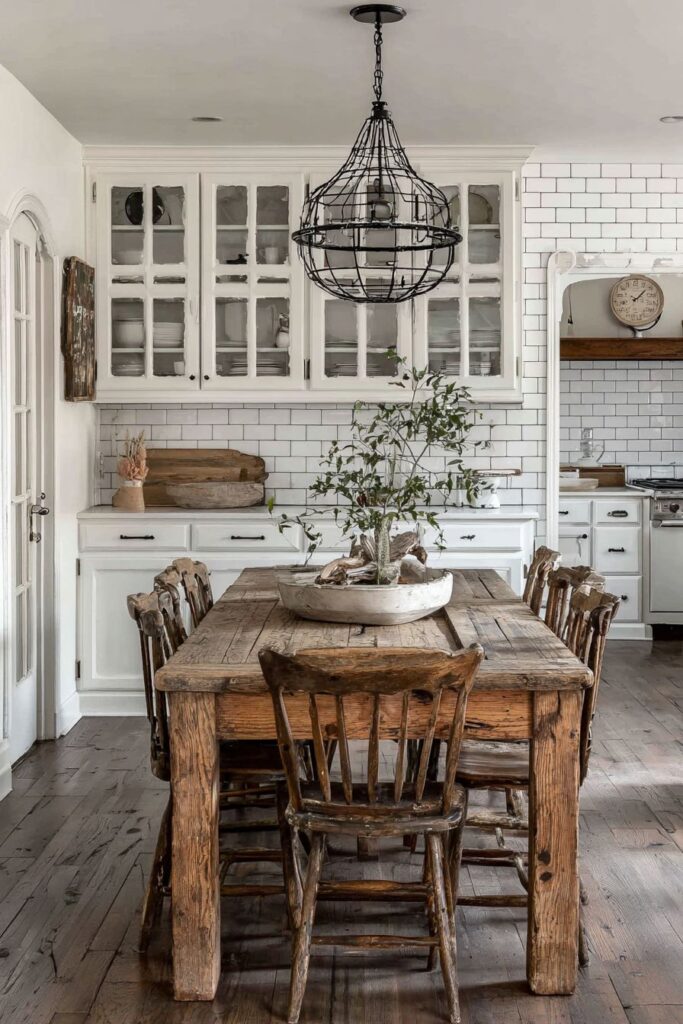
Key Design Tips:
- Collect chairs over time rather than purchasing complete matching sets for authentic farmhouse character
- Balance rustic elements with clean, simple materials like subway tile to prevent visual overwhelm
- Choose lighting fixtures that contribute to rather than compete with your collected aesthetic
- Refinish antique pieces carefully to preserve character while ensuring functional durability
- Display collections that reflect your personal interests while maintaining visual cohesion through color or material
10. Custom Built-In Efficiency

Maximizing space efficiency while maintaining farmhouse charm requires creative built-in solutions that serve multiple functions while contributing to the overall design aesthetic. A custom corner banquette with hidden storage underneath demonstrates how thoughtful construction can address practical needs while creating the intimate, cozy atmosphere that defines successful farmhouse dining spaces. The upholstery in vintage grain sack fabric adds authentic textural interest while providing comfortable seating.
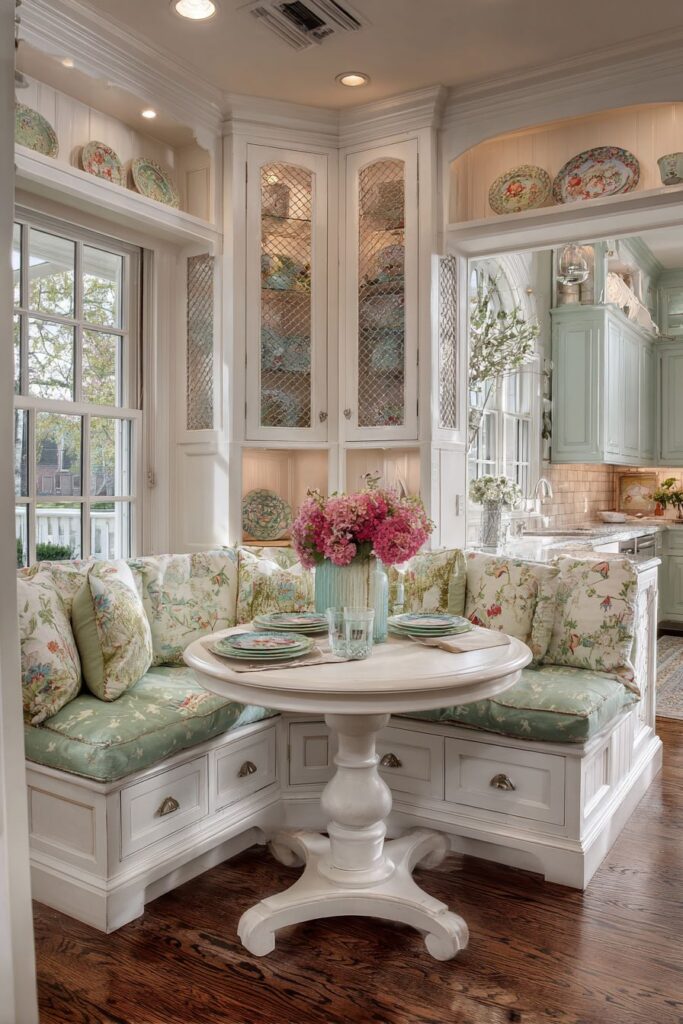
The round farmhouse table with pedestal base maximizes the cozy seating arrangement while allowing easy access from all directions. This combination creates an efficient layout that accommodates more diners in a smaller footprint than traditional rectangular arrangements, proving that farmhouse style adapts beautifully to space constraints without sacrificing functionality or charm.
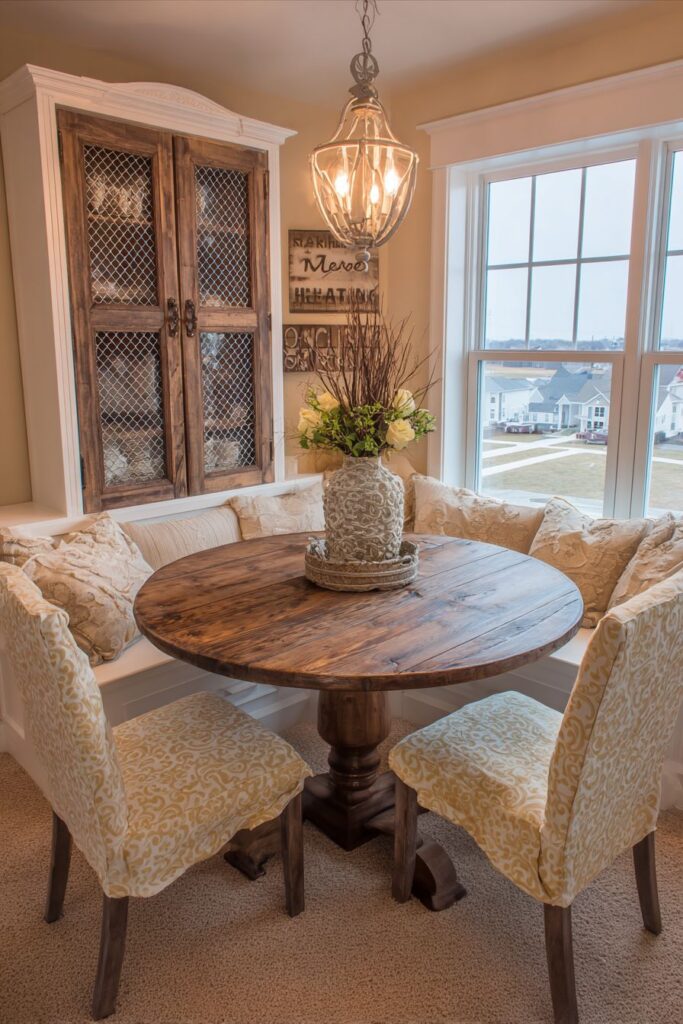
Chicken wire cabinet doors on the built-in hutch display everyday dishes while protecting them from dust and damage, creating storage solutions that become decorative features. The visible contents contribute to the lived-in aesthetic while maintaining organization and accessibility essential to daily life. Natural light from nearby windows emphasizes the practical comfort and authentic styling details that make this design both beautiful and functional.
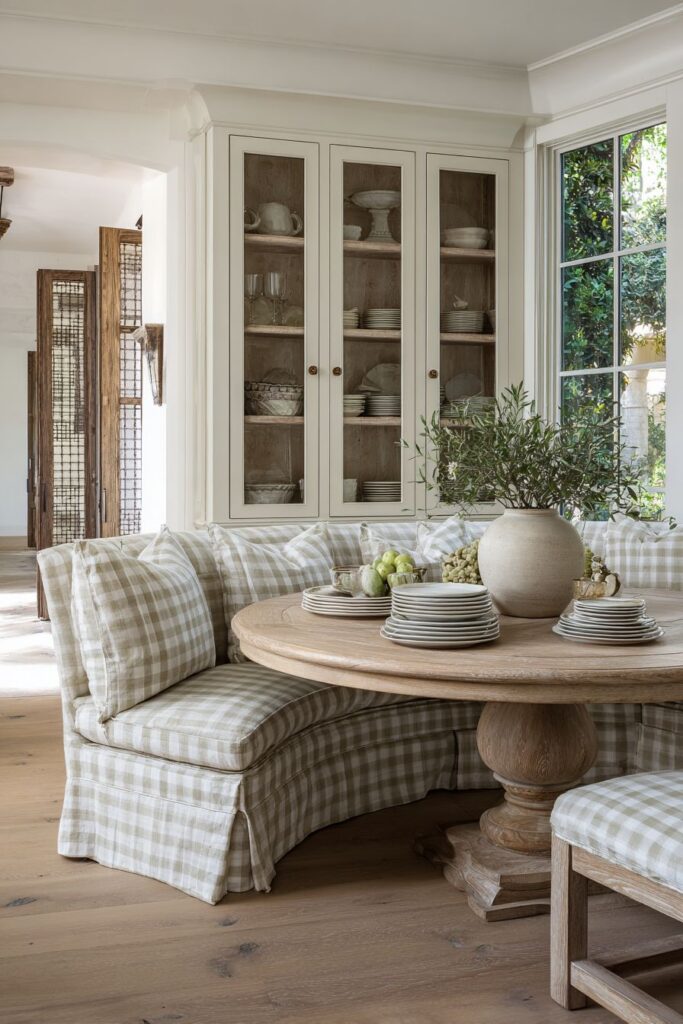
Key Design Tips:
- Design built-in storage with both hidden and display components to balance organization needs
- Choose fabrics that reference farmhouse heritage while meeting durability requirements for daily use
- Size round tables appropriately for your banquette dimensions to ensure comfortable seating clearance
- Use chicken wire or similar materials that provide protection while maintaining visual access to displayed items
- Position built-ins to take advantage of natural light while maintaining functional access for daily use
11. Live-Edge Natural Beauty
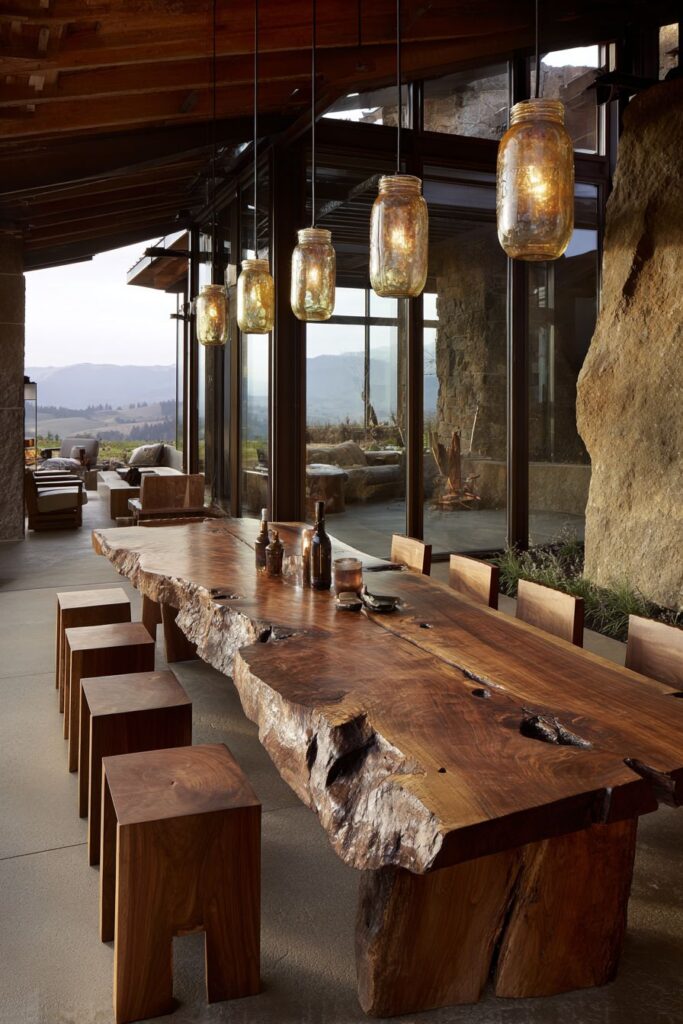
Celebrating the organic beauty of natural wood, the live-edge dining table concept showcases imperfections and knots as design features rather than flaws to be hidden or corrected. This massive table displays the natural edge of the tree, complete with bark remnants and irregular contours that tell the story of growth and time. Simple wooden stools and benches complement the table’s organic form while maintaining the honest, unadorned aesthetic that defines authentic farmhouse style.
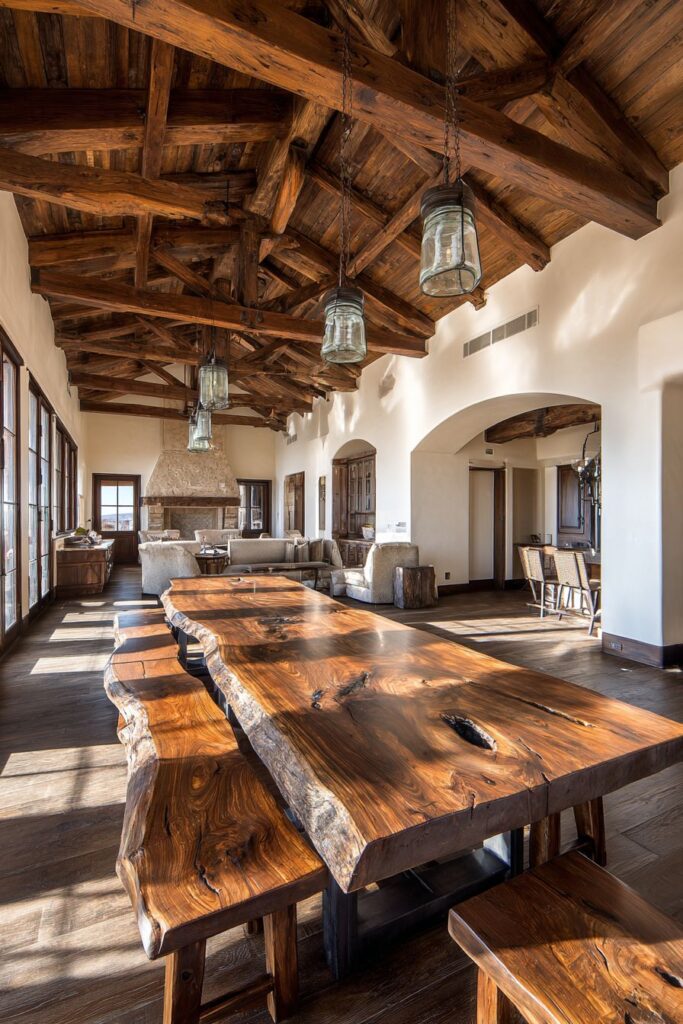
Exposed wooden ceiling joists add architectural interest while honoring traditional construction methods that left structural elements visible as both functional and decorative features. This approach celebrates the bones of the building while creating visual rhythm and textural interest that enhances the room’s rustic character. The natural materials create a harmonious palette that feels grounded and connected to nature.

Mason jar pendant lights provide task lighting while referencing the agricultural heritage central to farmhouse style. These humble fixtures transform everyday objects into functional art, demonstrating the farmhouse philosophy of finding beauty in practical items. The combination of organic wood forms and repurposed materials creates an authentic aesthetic that celebrates resourcefulness and creativity over expensive purchases.
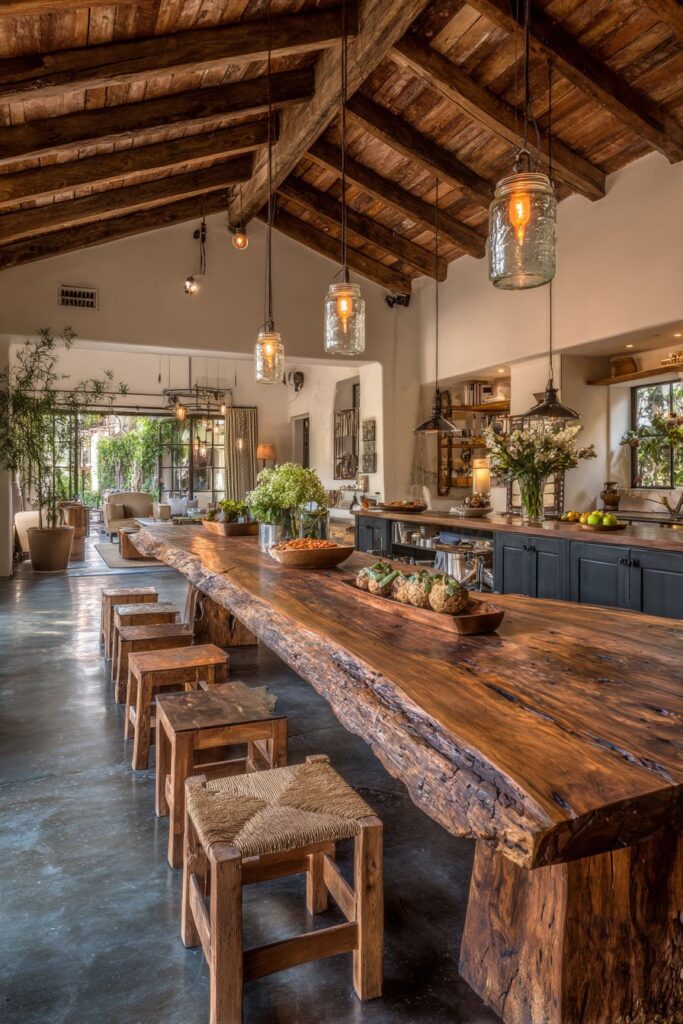
Key Design Tips:
- Select live-edge pieces that display interesting grain patterns and natural character marks
- Pair organic table forms with simple seating that doesn’t compete with the natural wood’s drama
- Use exposed structural elements to add architectural interest while honoring traditional construction
- Choose lighting fixtures that reference agricultural heritage through materials or forms
- Maintain the organic theme throughout the space while ensuring adequate structural support for large pieces
12. Flexible Space Planning
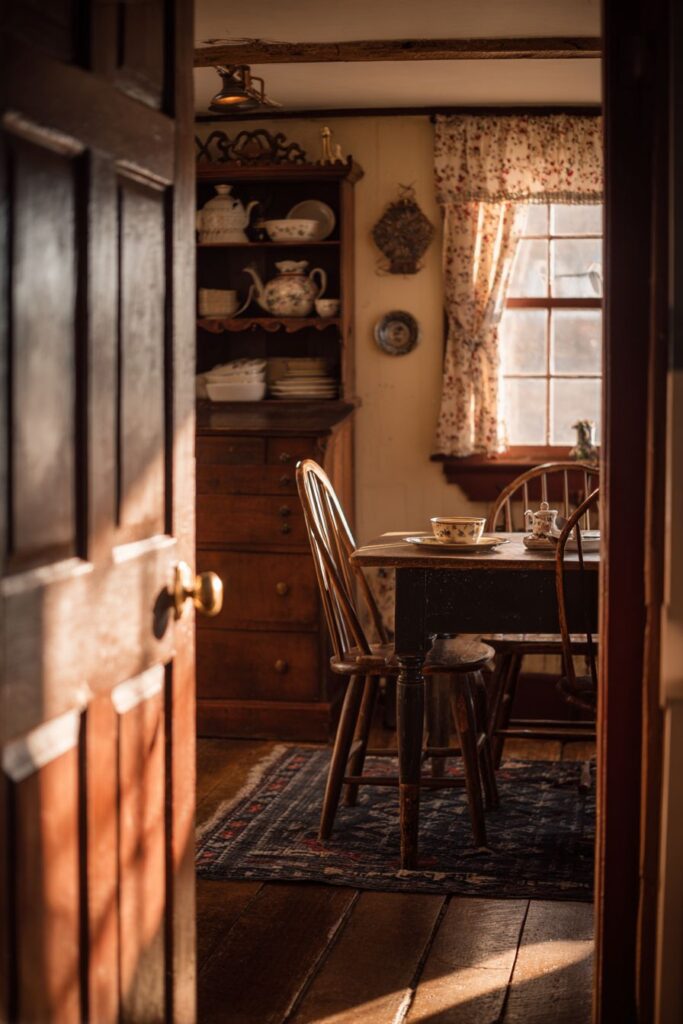
Adapting farmhouse style to varying space and entertaining needs requires furniture selections that provide flexibility without sacrificing authentic character. The gate-leg drop-leaf table in weathered pine demonstrates how traditional furniture forms address modern lifestyle requirements, expanding when needed for larger gatherings while maintaining a compact footprint for daily use. This approach honors the practical heritage of farmhouse design while meeting contemporary space constraints.
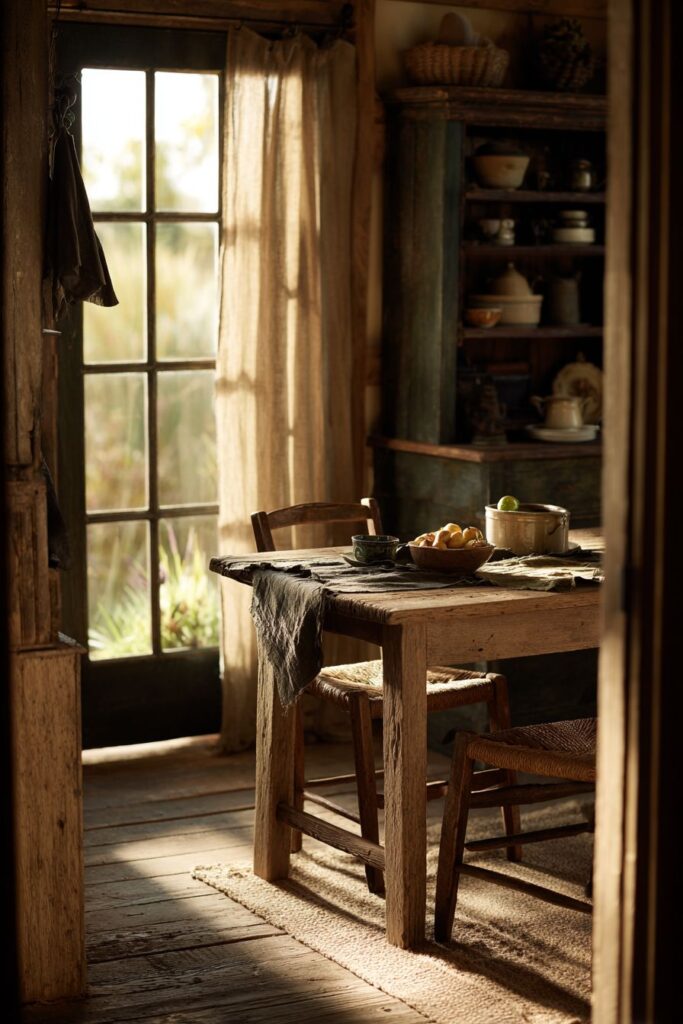
Ladder-back chairs with rush seats provide traditional farmhouse seating that stacks or stores efficiently when not needed, maximizing floor space while maintaining authentic materials and construction methods. The natural materials age beautifully over time, developing patina and character that enhance rather than diminish their appearance. This investment in quality traditional pieces pays dividends in both durability and aesthetic development.
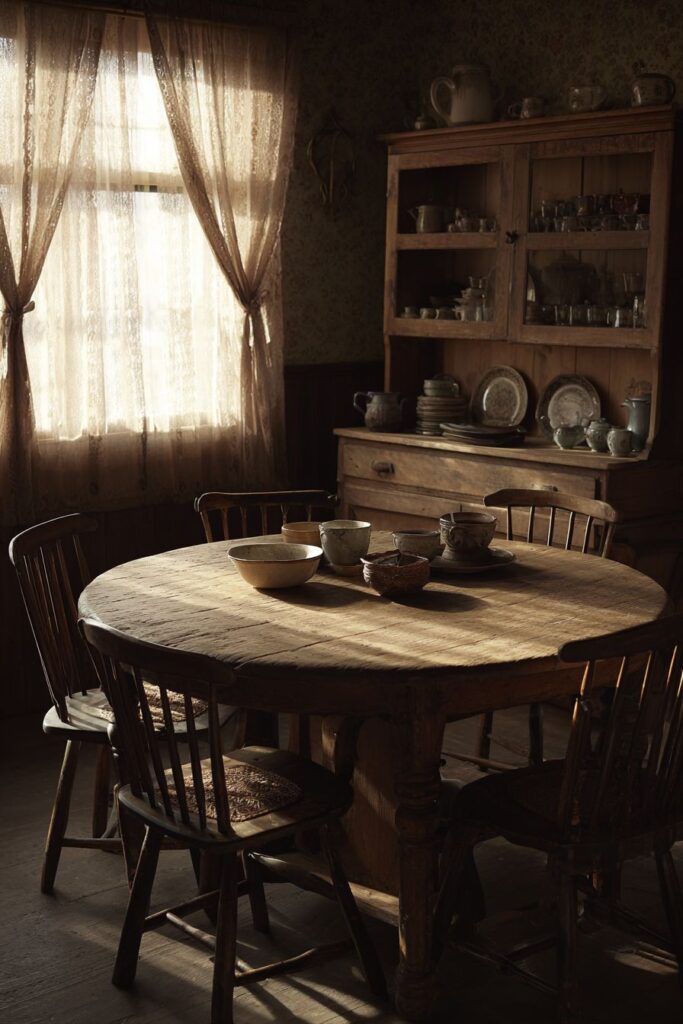
A vintage pie safe displays ceramic serving pieces and vintage linens, creating storage solutions that honor the farmhouse tradition of preserving and displaying useful items beautifully. The perforated tin doors provide ventilation while protecting contents, demonstrating the ingenuity of traditional design solutions that serve practical purposes while contributing to the overall aesthetic appeal.

Key Design Tips:
- Choose expandable tables that maintain proportional beauty in both expanded and contracted positions
- Invest in stackable or easily stored seating that doesn’t compromise on authentic materials or construction
- Use traditional storage pieces like pie safes that serve practical purposes while contributing to authentic atmosphere
- Plan furniture arrangements that allow for easy reconfiguration based on entertaining needs
- Select pieces with natural materials that improve with age and use rather than showing wear as damage
13. Substantial Traditional Forms
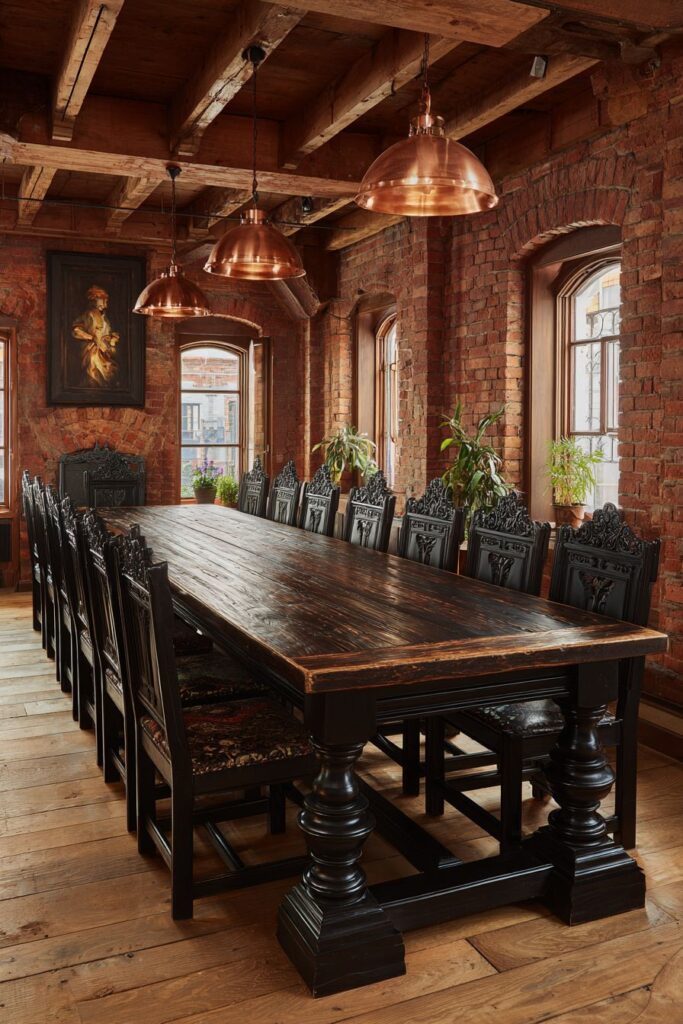
The refectory-style dining table represents farmhouse design at its most substantial and impressive, featuring thick plank construction and heavy turned legs that demonstrate the craftsmanship and material quality valued in traditional furniture making. This design approach celebrates permanence and quality over trends, creating furniture pieces that serve families for generations while developing character and patina that cannot be artificially created.
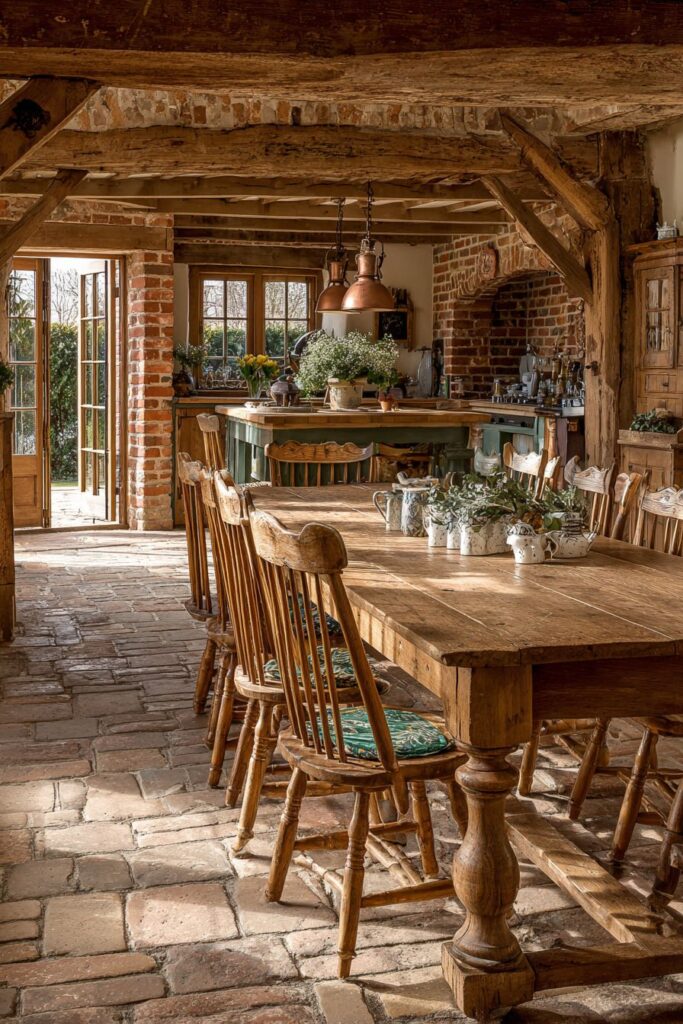
High-back wooden chairs with carved details complement the substantial table while providing comfortable seating that matches the formal presence of the refectory form. The carved elements add visual interest and demonstrate the hand-craftsmanship that distinguishes authentic farmhouse pieces from mass-produced alternatives. These details create talking points while contributing to the overall sense of quality and attention to detail.

Exposed brick walls provide textural contrast while copper pendant lights add warmth through both their material properties and the quality of light they produce. The combination of natural materials creates a rich, layered aesthetic that feels both rustic and refined, demonstrating how farmhouse style successfully balances casual comfort with sophisticated design sensibilities.
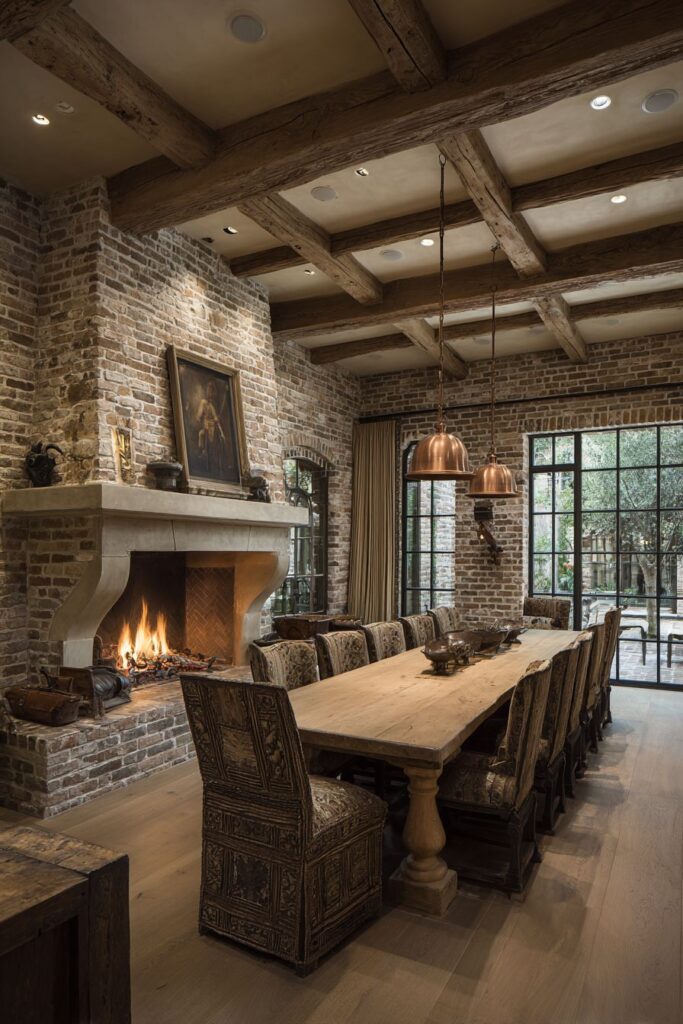
Key Design Tips:
- Invest in substantial furniture pieces with visible quality construction and traditional joinery methods
- Choose seating with carved or detailed elements that demonstrate craftsmanship while providing comfort
- Use natural materials like brick and copper that age beautifully and contribute to authentic atmosphere
- Balance substantial furniture with appropriate room proportions to maintain visual harmony
- Select pieces with traditional forms that reference historical furniture making while meeting contemporary needs
14. Intimate Breakfast Nook
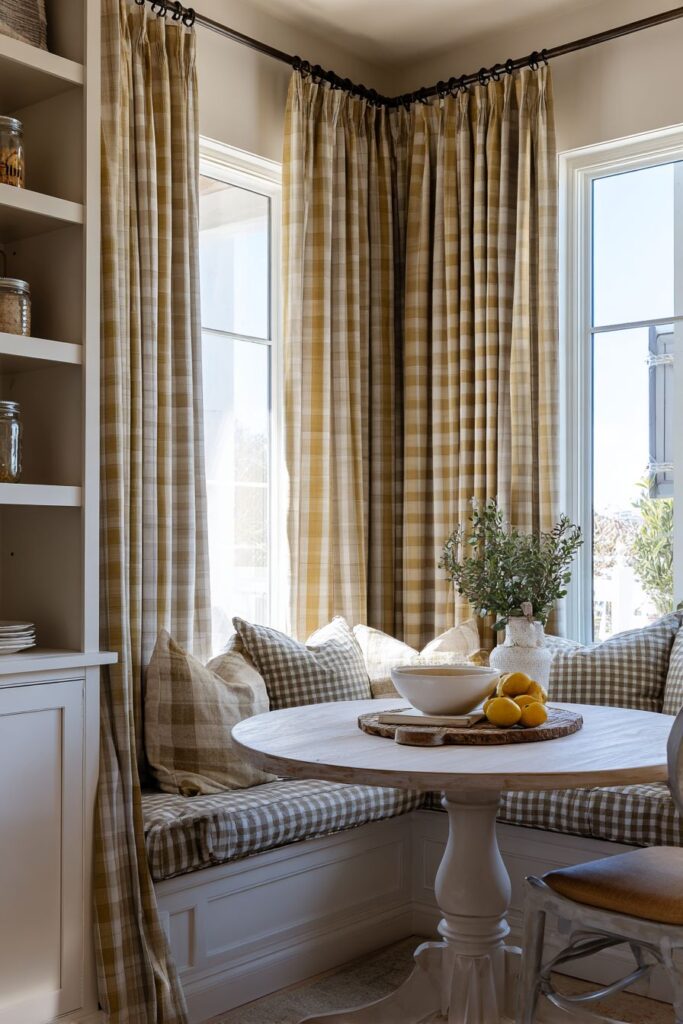
Creating intimate dining spaces within larger homes requires careful attention to scale and proportion while maintaining the welcoming character that defines farmhouse style. A built-in breakfast nook with bench seating and a small round farmhouse table creates a cozy gathering spot perfect for casual meals and morning coffee rituals. The painted pedestal base adds visual lightness while maintaining structural support.
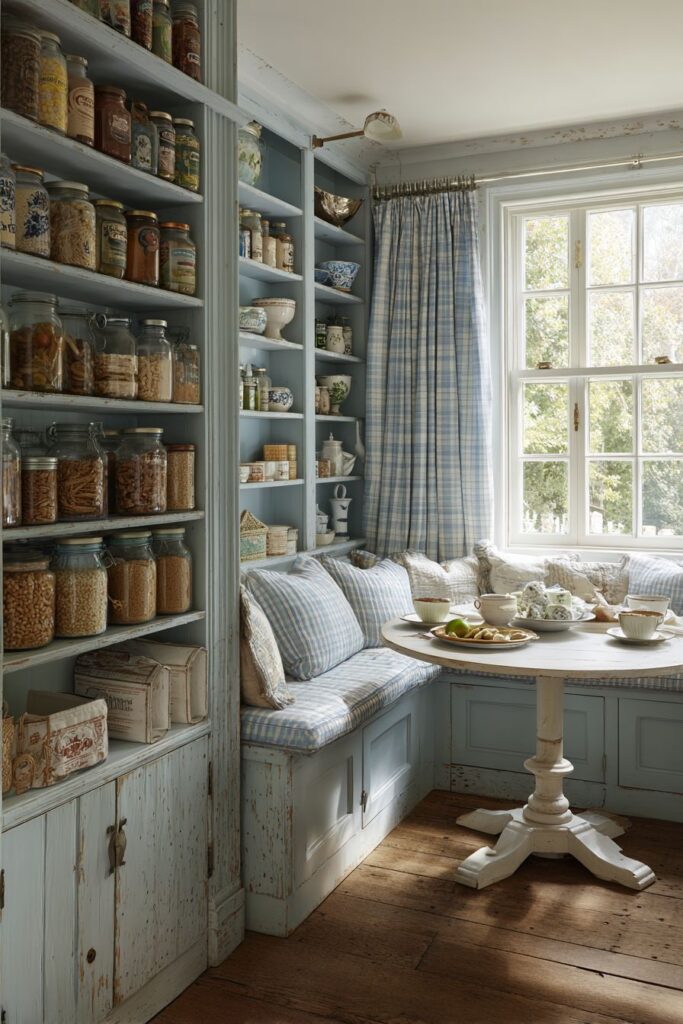
Gingham cushions and vintage quilts introduce traditional patterns and comfortable textures while providing color and warmth that can change seasonally. These textile elements soften the wooden surfaces while referencing the agricultural heritage and handcraft traditions central to farmhouse style. The layering of patterns and textures creates visual interest without overwhelming the intimate scale.
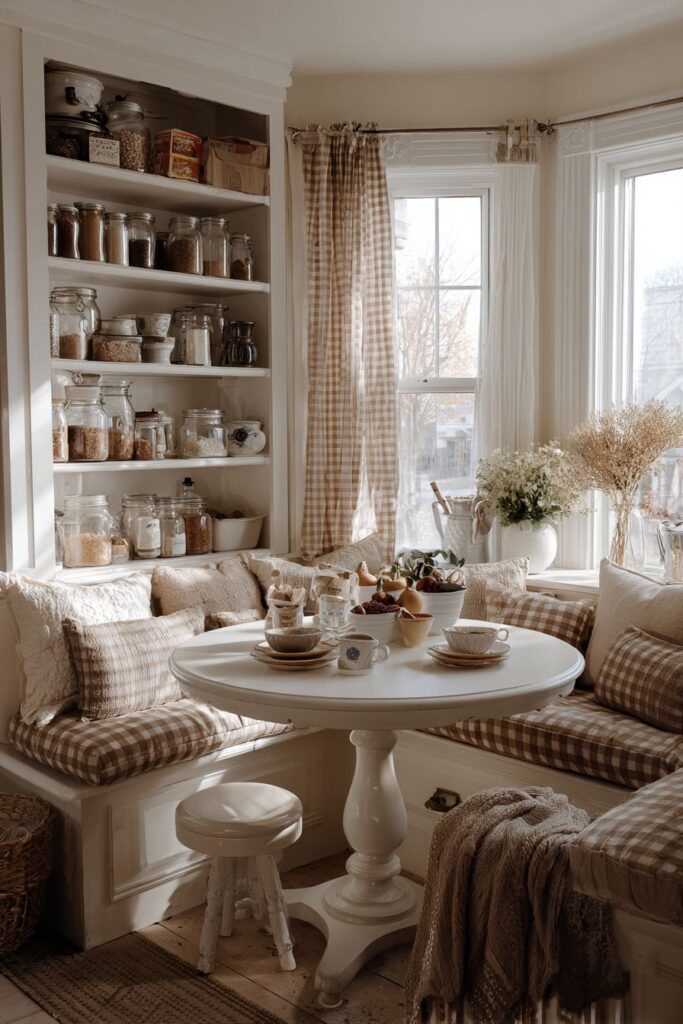
Open shelving displays mason jars filled with pantry staples, creating storage solutions that become decorative elements while maintaining the practical, organized aesthetic essential to farmhouse living. The visible contents contribute to the lived-in atmosphere while ensuring easy access to daily cooking and baking needs. Morning light filtering through checkered curtains creates a warm, welcoming atmosphere perfect for starting the day.
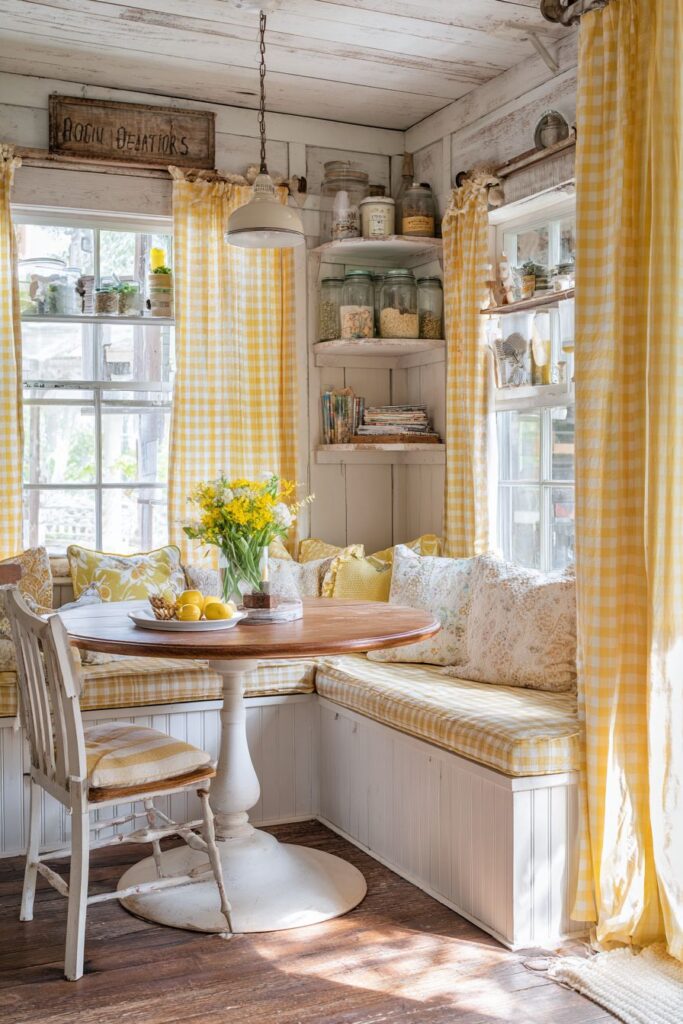
Key Design Tips:
- Size breakfast nooks appropriately for daily use rather than maximum capacity to maintain intimacy
- Use traditional patterns like gingham sparingly as accent elements rather than dominant design features
- Display functional items attractively to maintain the practical, uncluttered farmhouse aesthetic
- Choose textiles that can be easily cleaned and changed seasonally for flexibility and practicality
- Position nooks to capture morning light while maintaining privacy and comfortable proportions
15. Creative Repurposing Solutions
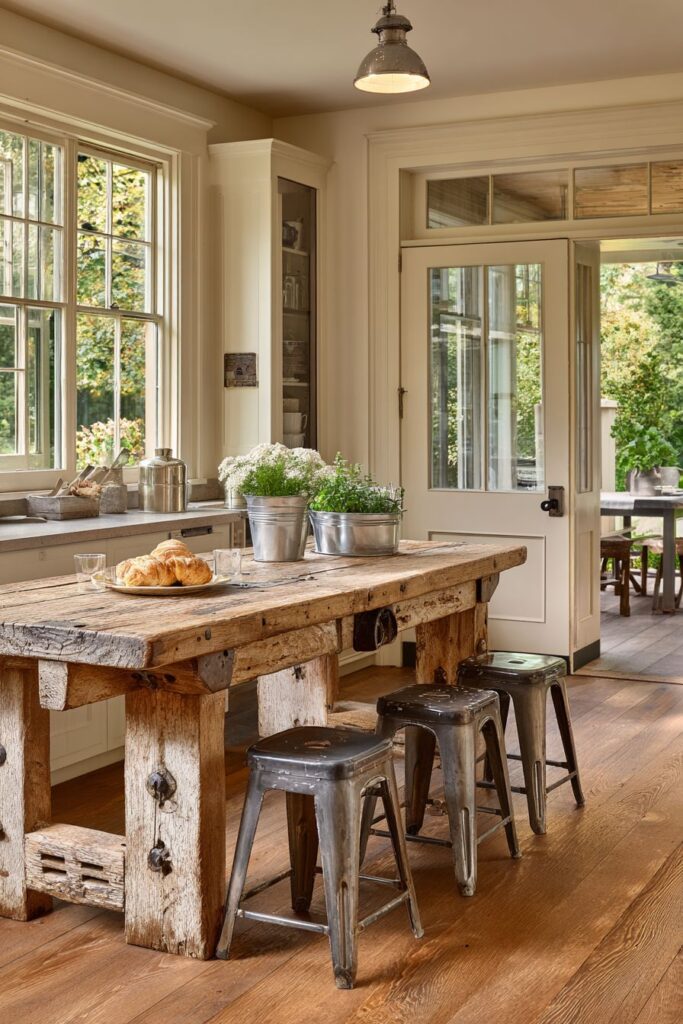
The farmhouse tradition of resourcefulness and creativity finds perfect expression in repurposed furniture that serves new functions while honoring its original purpose and construction. A converted workbench serving as a unique dining table demonstrates how industrial pieces can transition into domestic use while retaining their authentic character and functional beauty. The original tool marks and hardware tell stories while providing textural interest that cannot be replicated.
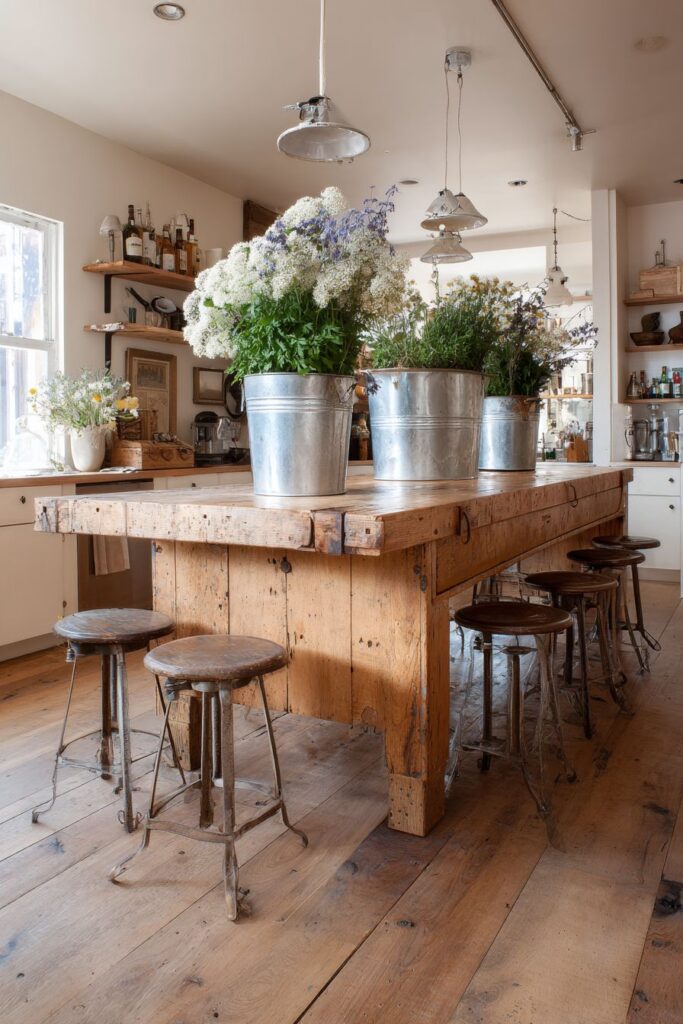
Mismatched vintage stools provide casual seating that maintains the workshop aesthetic while offering flexibility for varying numbers of diners. The collection of different heights and styles creates visual interest while honoring the collected-over-time philosophy central to authentic farmhouse design. Each piece contributes its own character while working harmoniously within the overall composition.
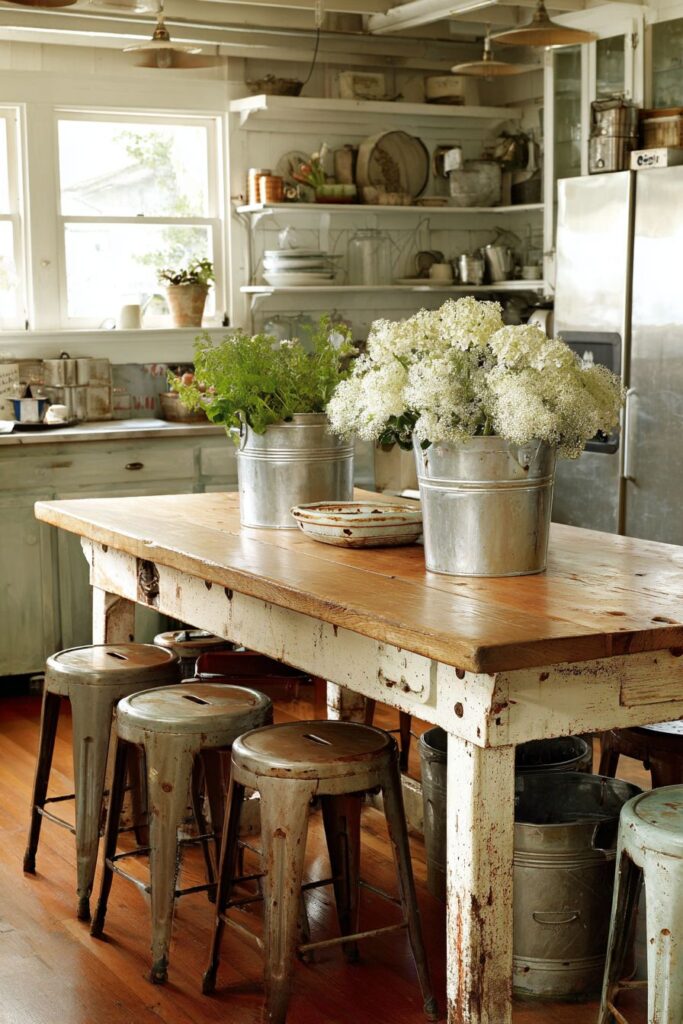
Galvanized buckets holding fresh herbs and flowers demonstrate how utilitarian objects can serve decorative purposes while maintaining their practical functionality. This approach celebrates the farmhouse tradition of finding beauty in everyday objects while creating connections between indoor and outdoor living spaces through the presence of growing plants and seasonal materials.
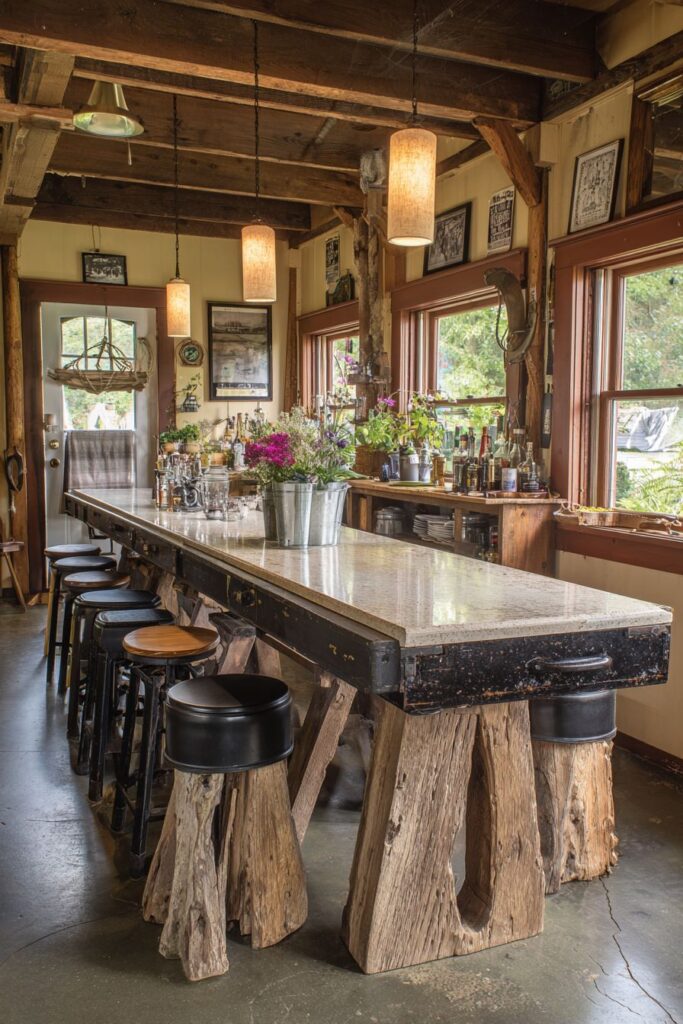
Key Design Tips:
- Look for industrial or workshop pieces with interesting original hardware and authentic wear patterns
- Maintain original finishes and markings that tell the story of the piece’s previous function
- Mix seating heights and styles carefully to create variety while maintaining visual harmony
- Use repurposed containers for plants and flowers to reinforce the resourceful farmhouse aesthetic
- Ensure repurposed pieces meet safety and stability requirements for their new dining functions
16. Traditional Joinery Showcase
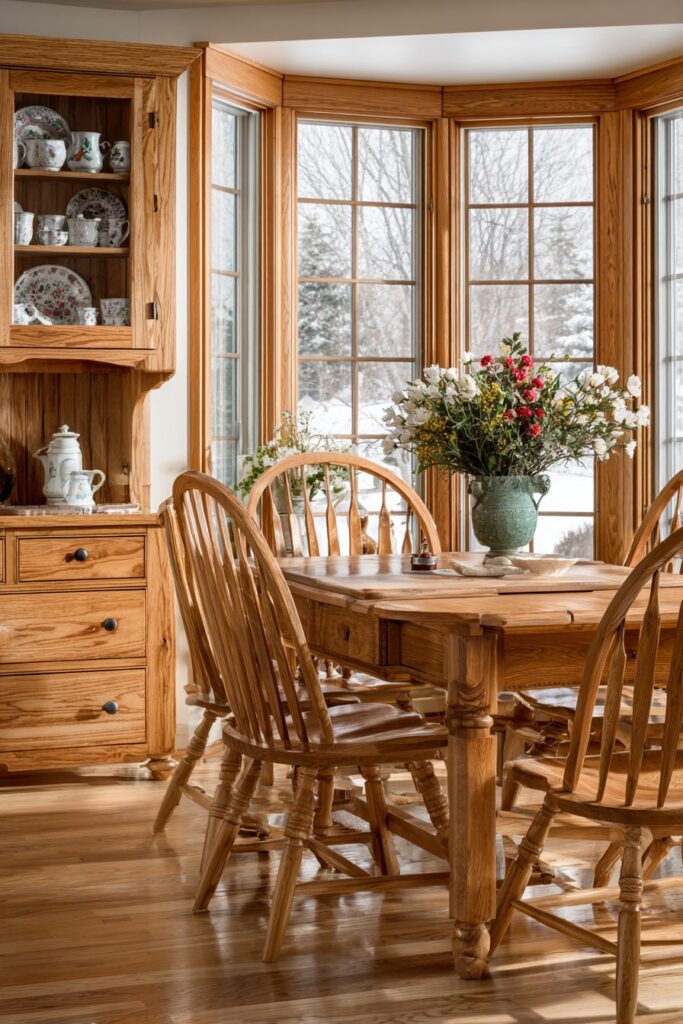
Authentic farmhouse furniture celebrates traditional woodworking techniques through visible construction details that become decorative elements rather than hidden structural necessities. A draw-leaf extension table in aged oak showcases mortise and tenon construction at the joints, demonstrating the craftsmanship and attention to detail that distinguishes handmade pieces from manufactured alternatives. These visible joints tell the story of the maker’s skill while ensuring structural integrity.
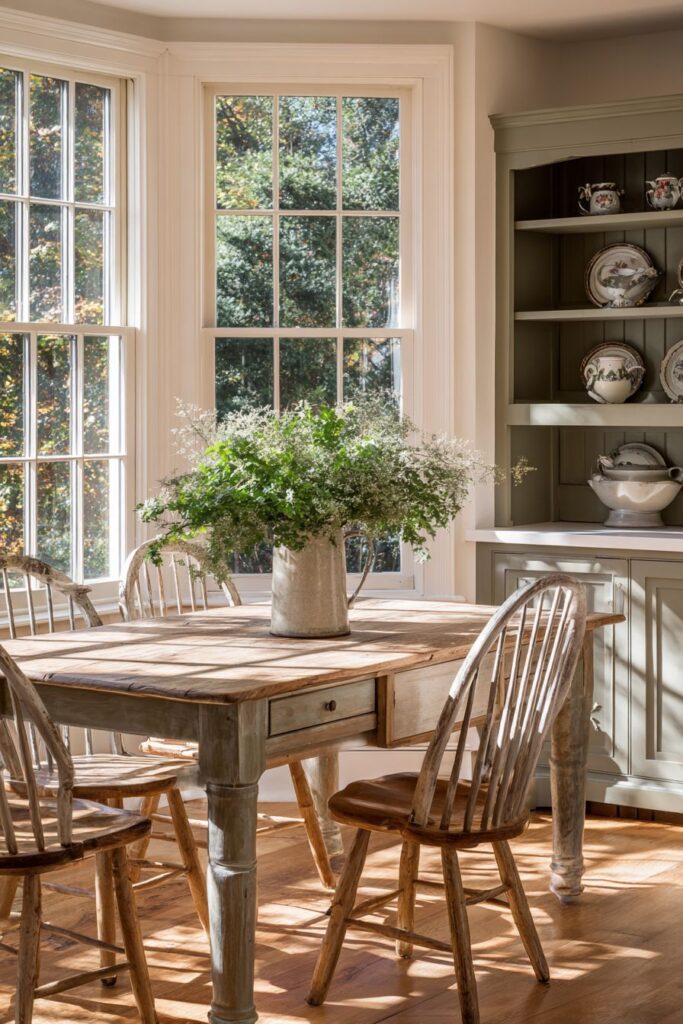
Bow-back Windsor chairs surrounding the table continue the tradition of superior construction methods while providing comfortable seating that has served families for centuries. The steam-bent backs and hand-shaped seats demonstrate how traditional techniques create both beauty and function, developing comfort through use while maintaining structural stability over time. The natural wood develops rich patina that enhances rather than diminishes with age.

A corner cupboard displays transferware and pewter, creating storage solutions that honor the farmhouse tradition of displaying useful items beautifully while protecting them from damage. The careful arrangement of collections creates visual interest while demonstrating the farmhouse values of quality over quantity and preservation of useful, beautiful objects through generations of family use.
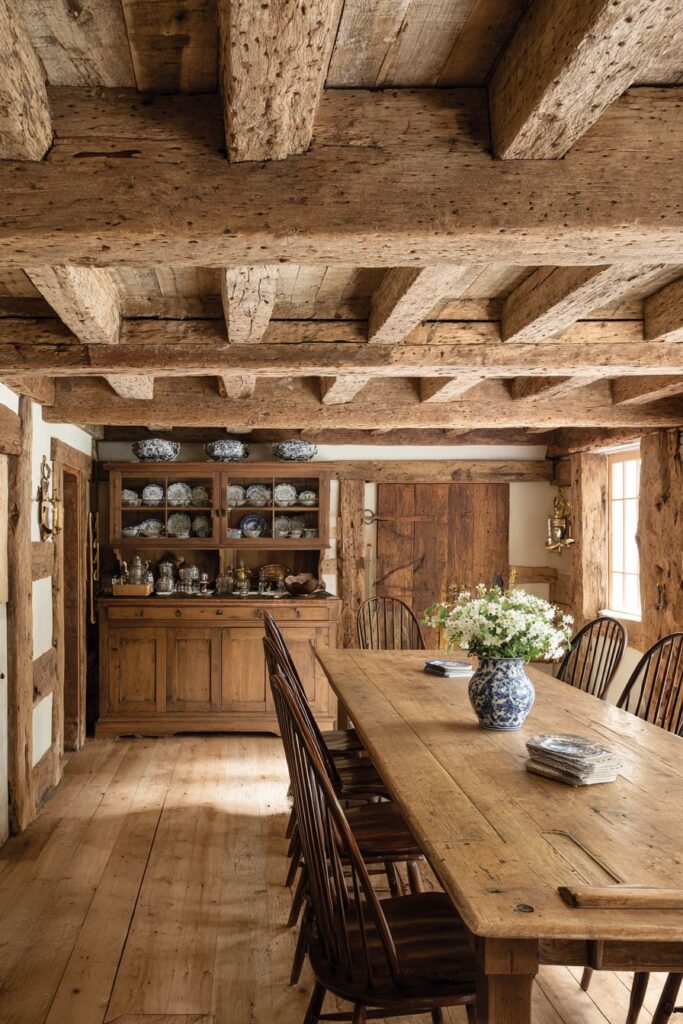
Key Design Tips:
- Seek pieces with visible traditional joinery that showcases woodworking craftsmanship
- Invest in furniture with construction methods that ensure longevity and develop character over time
- Display collections that reflect farmhouse values of utility, beauty, and historical continuity
- Choose pieces with natural finishes that improve with age rather than showing wear as deterioration
- Arrange displays to tell stories about family history and personal collecting interests while maintaining organization
17. Utilitarian Beauty Philosophy

The sawbuck trestle table embodies the farmhouse philosophy that functional design creates its own aesthetic appeal, featuring cross-brace supports and heavy plank construction that prioritizes structural integrity while creating visual interest through honest construction methods. The natural edge details celebrate the organic beauty of wood while demonstrating respect for materials and traditional craftsmanship techniques.
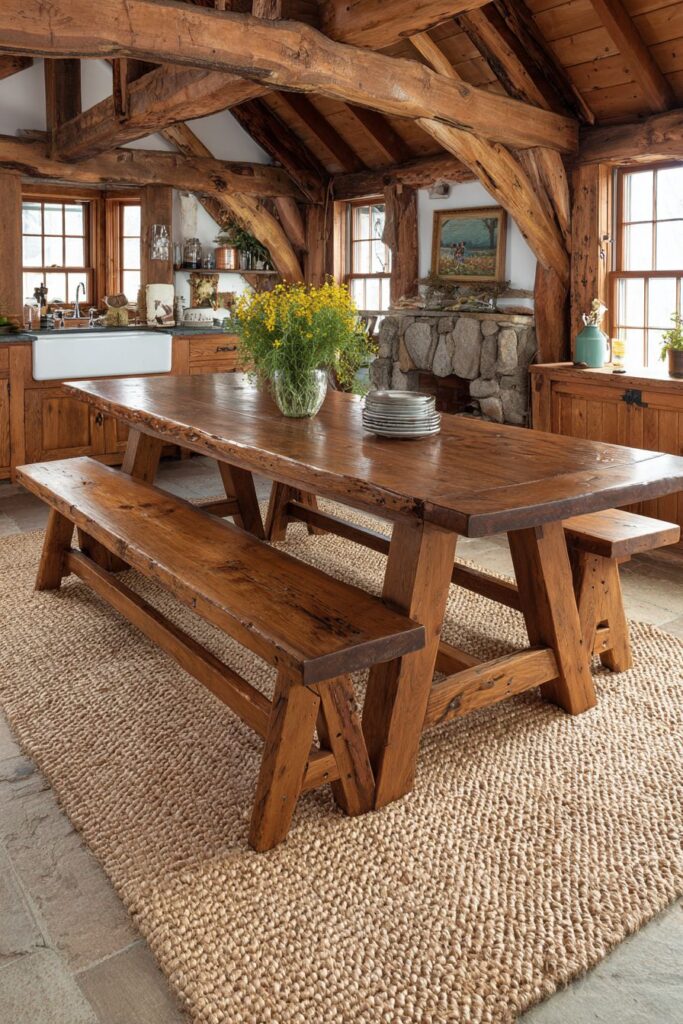
Backless wooden benches provide seating that tucks neatly under the table when not in use, maintaining clean lines while offering flexible seating arrangements for varying group sizes. The simple construction allows the wood’s natural beauty to dominate while ensuring comfortable, stable seating that serves practical needs without unnecessary ornamentation or complexity.

A repurposed farmhouse sink serving as a serving station demonstrates creative adaptive reuse while honoring the agricultural heritage central to farmhouse style. The practical functionality of the deep basin and substantial construction makes it ideal for serving large gatherings while its authentic character adds visual interest and conversation-starting focal point that bridges past and present uses.

Key Design Tips:
- Choose furniture forms that celebrate structural elements as decorative features
- Use simple construction methods that allow natural materials to provide visual interest
- Incorporate repurposed architectural elements that maintain their functional capabilities
- Select pieces that demonstrate the farmhouse values of utility, durability, and honest construction
- Arrange furniture to emphasize clean lines while maintaining flexibility for varying uses and group sizes
18. Time-Worn Elegance
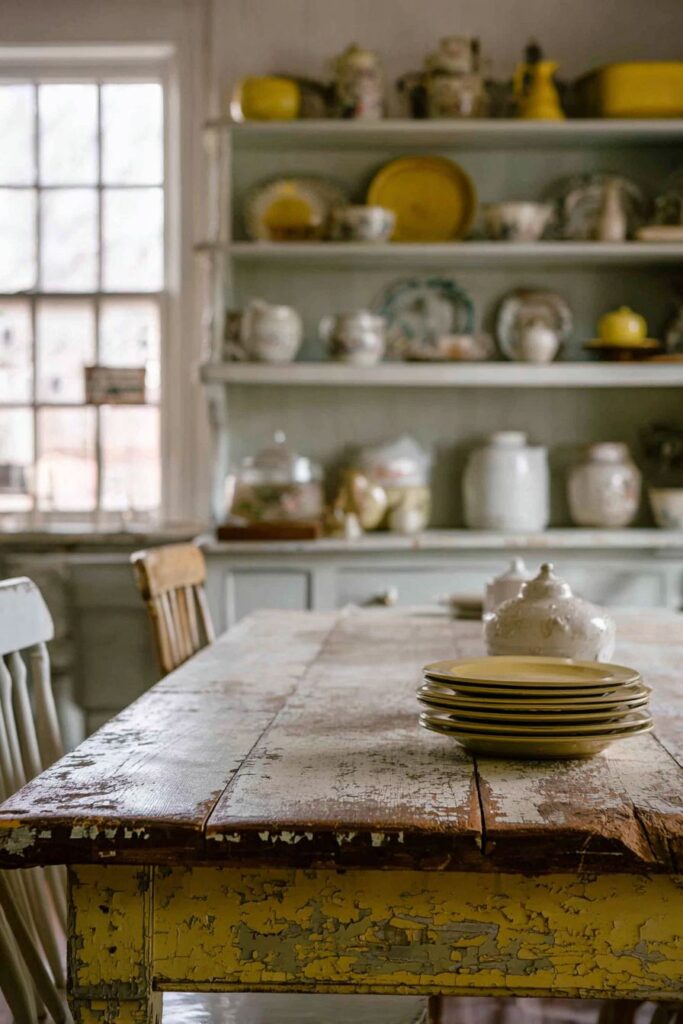
The painted farm table in chippy white finish represents the farmhouse aesthetic at its most refined, where gentle wear patterns reveal layers of history while maintaining elegant proportions and graceful aging. The natural wood showing through years of use creates depth and visual interest that cannot be artificially replicated, demonstrating how authentic patina develops through daily use and careful maintenance over generations of family service.
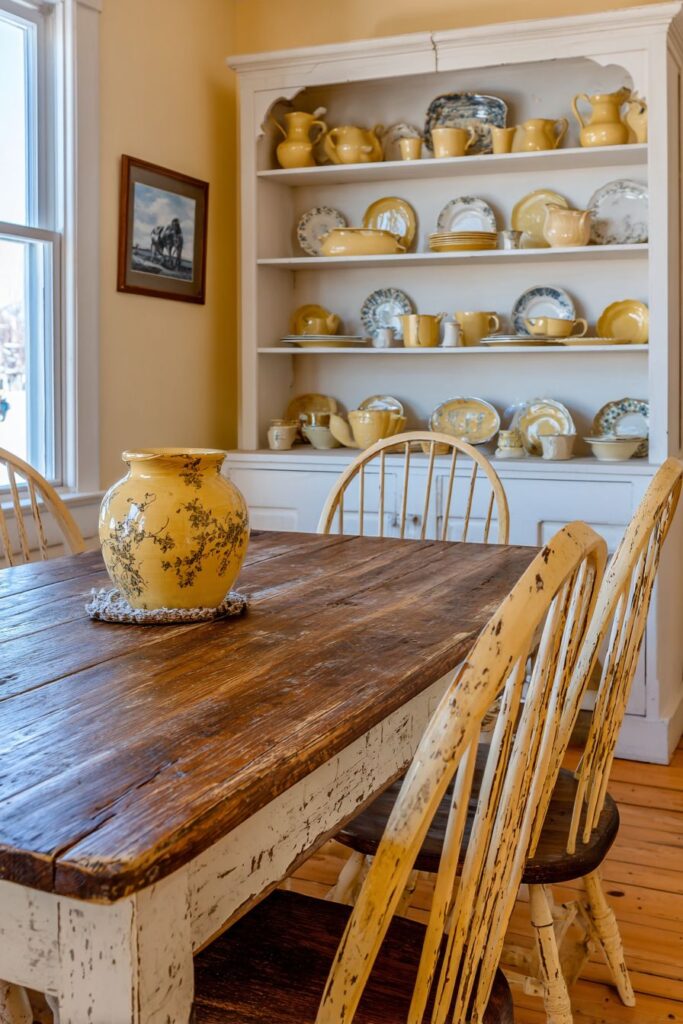
Spindle-back chairs in coordinating paint create a unified yet collected appearance that suggests pieces chosen over time rather than purchased as a matching set. The subtle variations in paint wear and finish create visual interest while maintaining color harmony, proving that authentic farmhouse style rewards patience and careful curation over quick decorating solutions that lack depth and character.
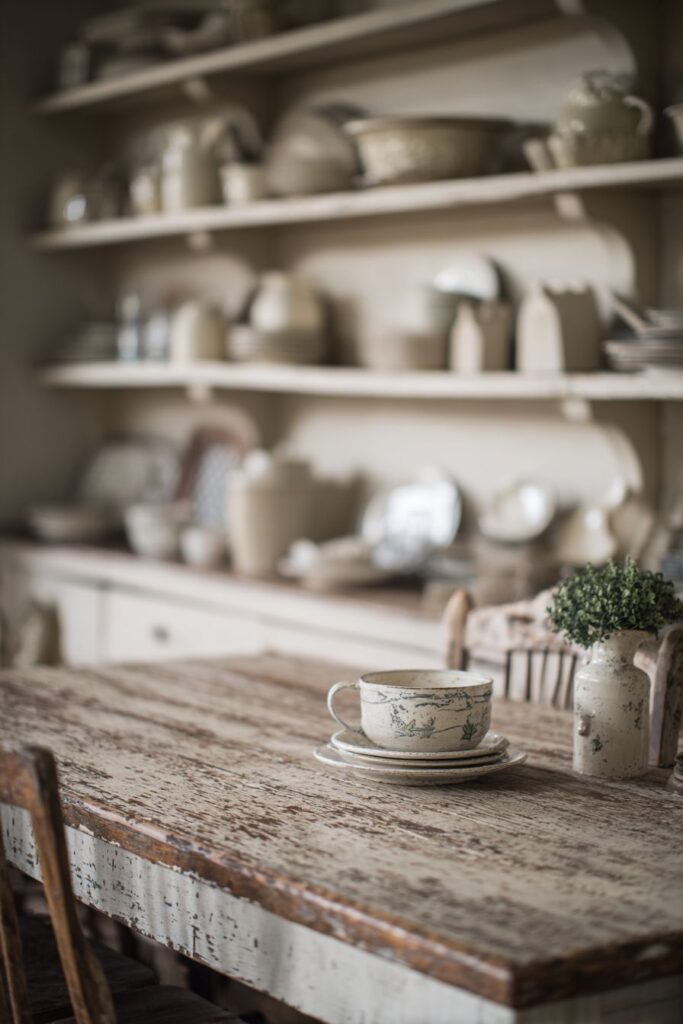
Vintage ironstone and yellowware displayed on open shelving add authentic period details while serving practical storage and display functions. The cream and white palette creates calm, cohesive color schemes while the varied shapes and sizes of utilitarian pottery pieces add textural interest and reference the agricultural heritage central to farmhouse living traditions.
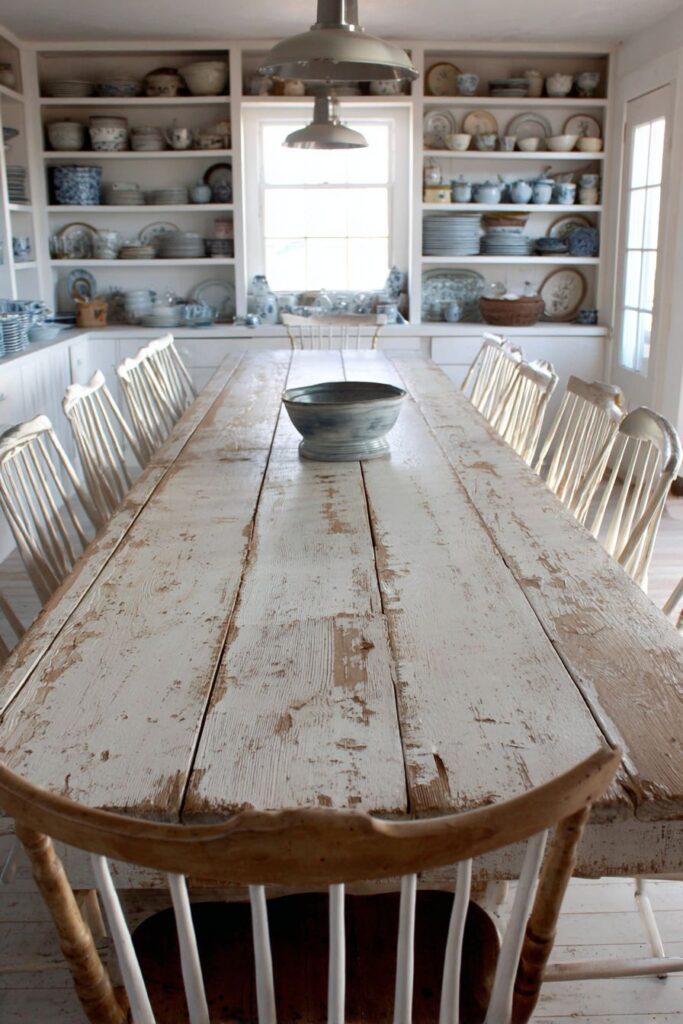
Key Design Tips:
- Choose painted pieces with authentic wear patterns that reveal wood undertones naturally
- Create unity through color families while allowing individual pieces to show unique character
- Display collections of utilitarian pottery that serves both practical and aesthetic purposes
- Maintain color palettes that feel calm and cohesive while incorporating natural material variations
- Invest in pieces with authentic aging rather than artificially distressed alternatives that lack depth
19. Hand-Forged Character
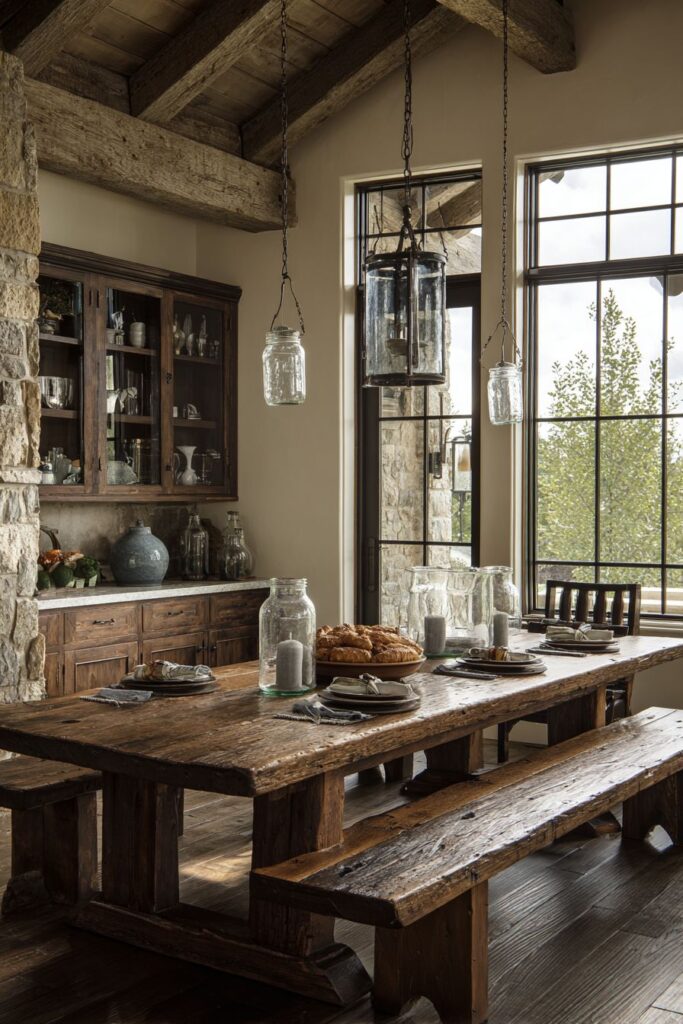
The harvest table featuring breadboard ends and dowel construction details showcases traditional woodworking techniques that create both structural integrity and visual interest through honest construction methods. Hand-hewn appearance on accompanying wooden benches demonstrates the farmhouse appreciation for craftsmanship that shows the maker’s hand while creating furniture that serves families for generations through quality construction and timeless design.
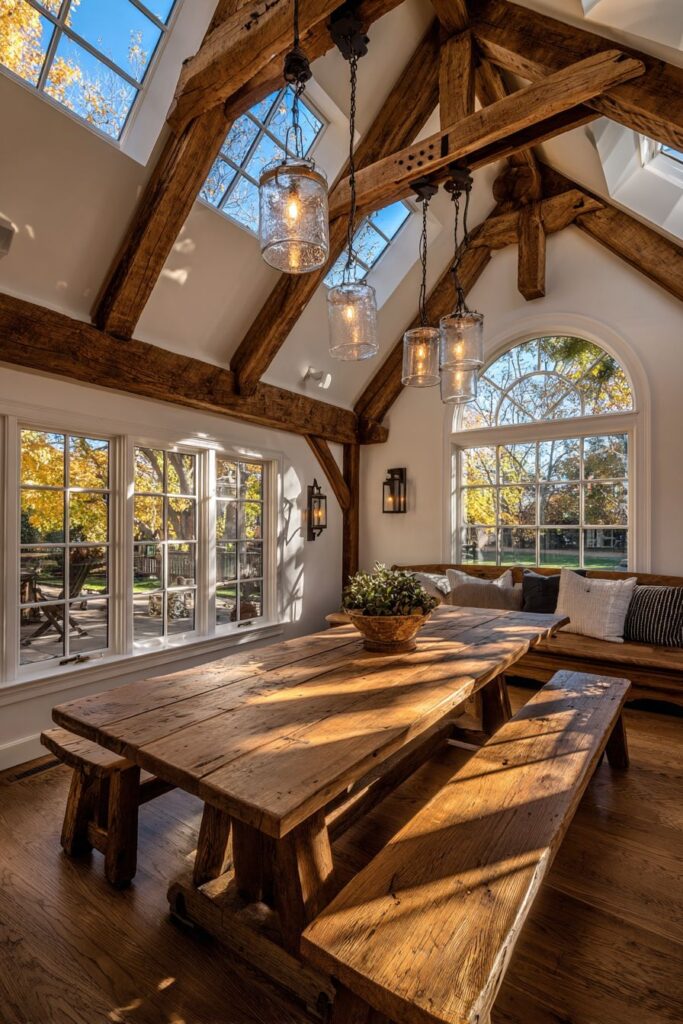
Wrought iron hardware on nearby cabinetry provides authentic period details while serving practical functions with durability that matches the substantial construction of traditional farmhouse furniture. The hand-forged elements add textural contrast to smooth wood surfaces while demonstrating the metalworking skills that complemented woodworking in traditional farmhouse construction and furniture making.
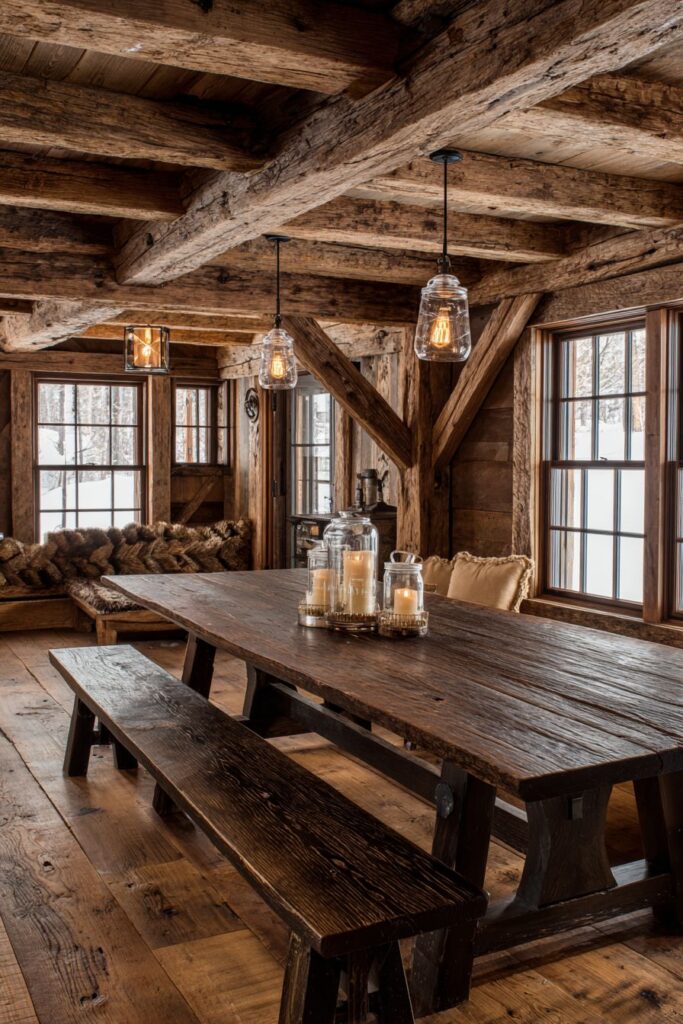
Mason jar pendant lights hanging from rough-hewn ceiling beams create lighting solutions that honor agricultural heritage while providing functional illumination for daily activities. The combination of repurposed materials and traditional construction methods demonstrates the farmhouse values of resourcefulness and creativity while creating unique fixtures that cannot be purchased but must be crafted.
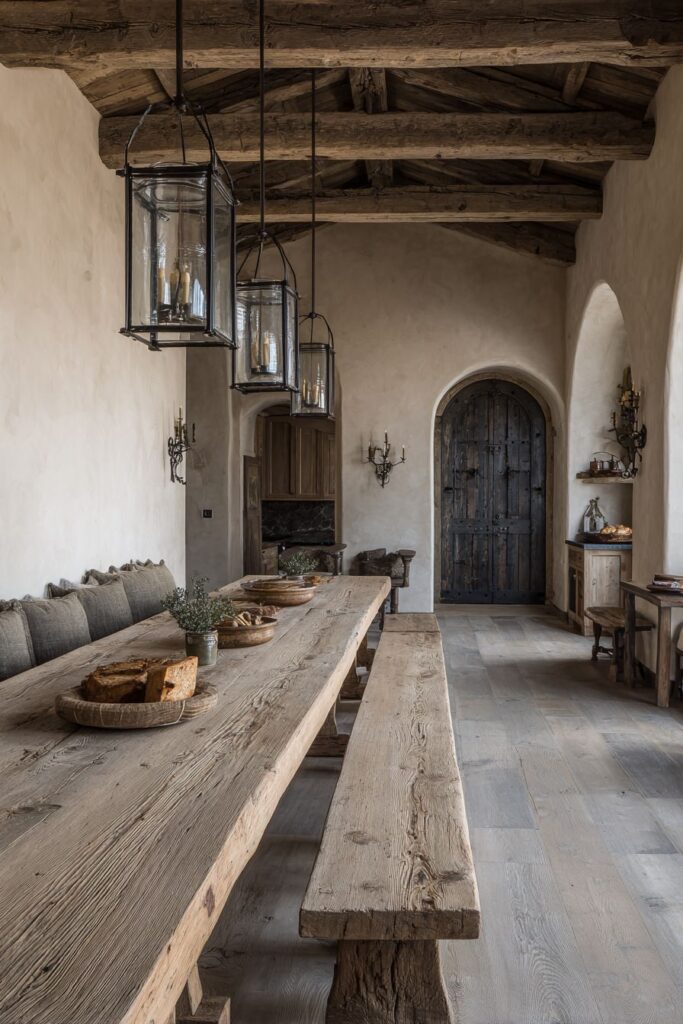
Key Design Tips:
- Seek furniture with visible construction details that showcase traditional woodworking methods
- Incorporate hand-forged hardware that demonstrates metalworking craftsmanship while serving practical functions
- Use repurposed materials creatively to create unique lighting and decorative elements
- Choose pieces with hand-hewn appearance that shows the maker’s individual touch and skill
- Combine different craft traditions through woodworking, metalworking, and textile elements that work harmoniously together
20. Humble Traditional Forms
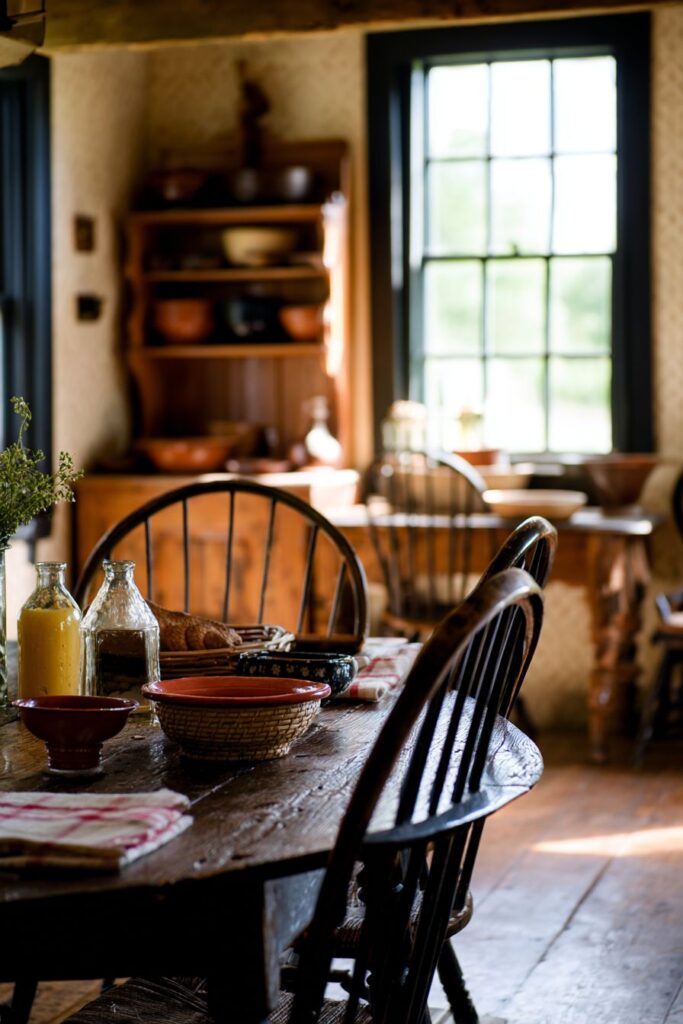
The cricket table with its distinctive three-leg design represents farmhouse furniture at its most essential and humble, demonstrating how simple forms can create elegant solutions while honoring traditional construction methods. The round top and unusual base create visual interest through pure form rather than ornamentation, proving that authentic farmhouse style finds beauty in functional simplicity and honest construction techniques.
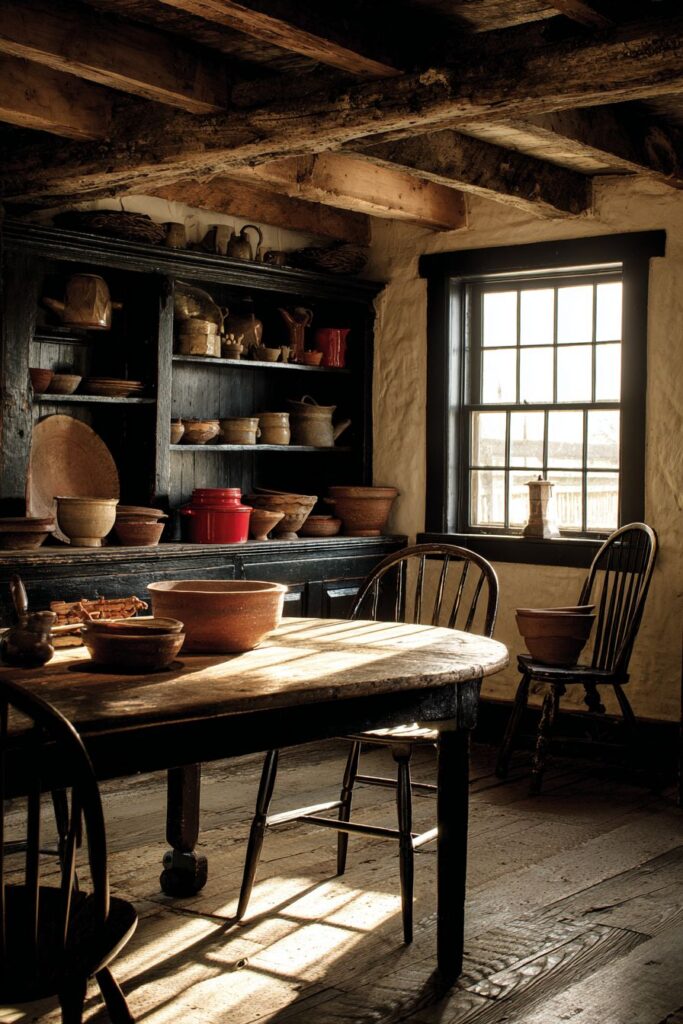
Rush-seated ladderback chairs complement the table’s simple construction while providing comfortable seating that has served families for centuries without modification or improvement. These traditional forms demonstrate how successful design transcends trends through superior function and timeless proportions that work as well today as they did generations ago.
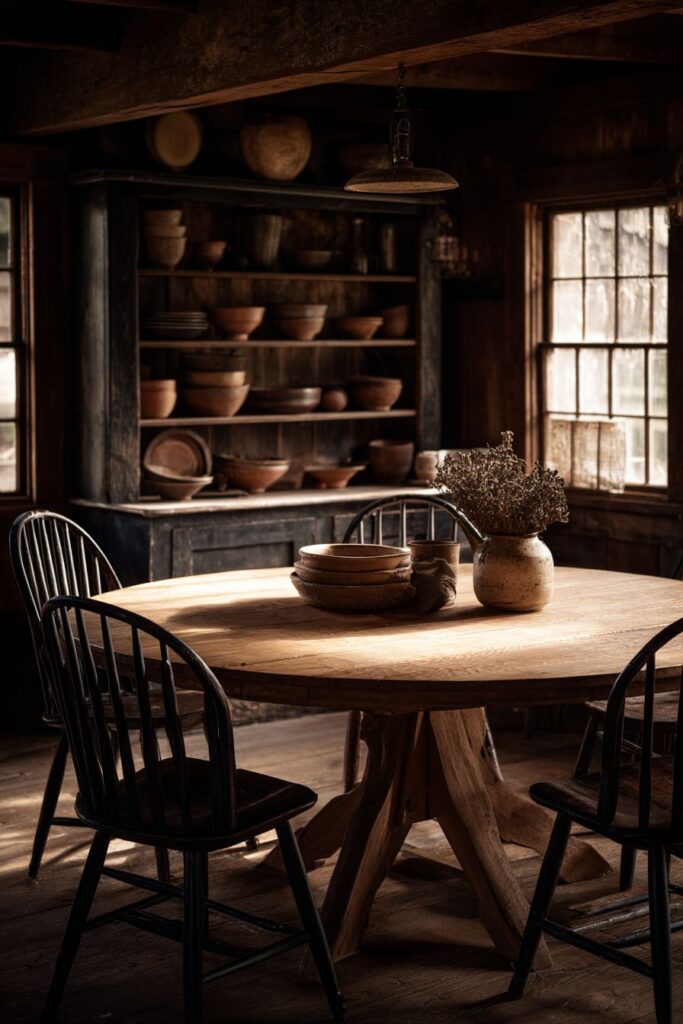
A step-back cupboard displays redware pottery and wooden bowls, creating storage solutions that honor the farmhouse tradition of displaying useful items beautifully while keeping them accessible for daily use. The graduated shelving provides visual interest while accommodating items of different sizes, demonstrating how traditional furniture forms address practical needs through thoughtful design rather than complex mechanisms.
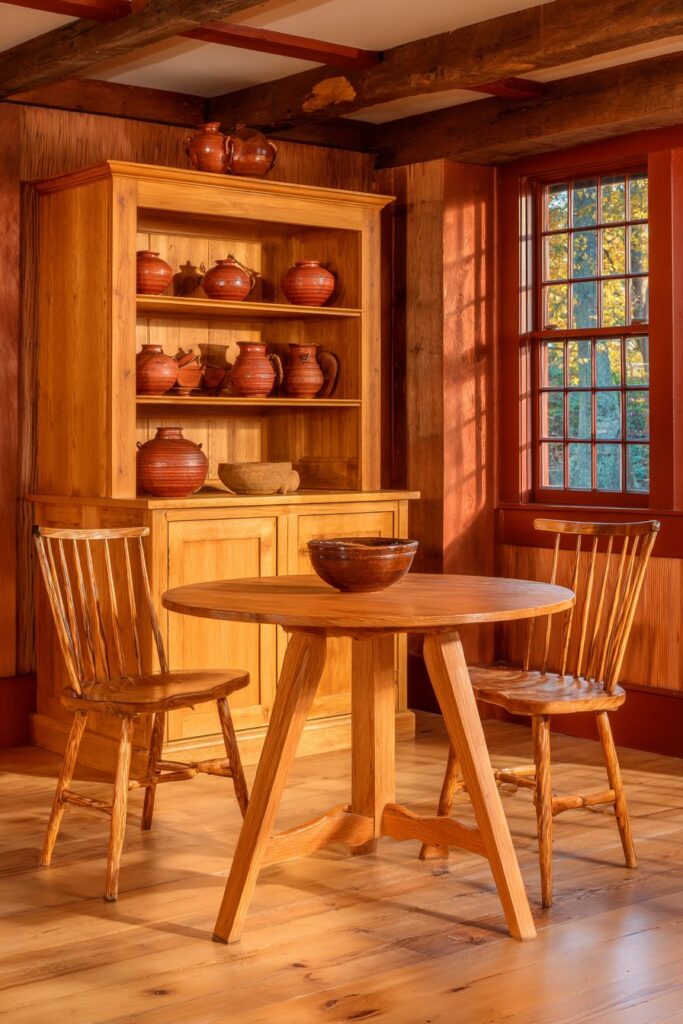
Key Design Tips:
- Appreciate simple furniture forms that achieve elegance through proportion rather than ornamentation
- Choose traditional construction methods that have proven successful over centuries of use
- Display collections of utilitarian items that demonstrate the farmhouse values of quality and functionality
- Invest in pieces with timeless forms that transcend decorating trends through superior design
- Create arrangements that celebrate humble materials and simple construction while maintaining beauty and function
Why These Farmhouse Dining Room Designs Stand Out
These twenty farmhouse dining room concepts represent the finest expressions of authentic agricultural-inspired design, each demonstrating different aspects of the farmhouse aesthetic while maintaining the core values that make this style enduringly popular. The reclaimed wood dining tables featured throughout showcase the farmhouse commitment to sustainability and history, where every scratch and grain pattern tells a story of previous use and natural beauty that cannot be manufactured or rushed.
The vintage chair collections and mismatched seating arrangements demonstrate the farmhouse philosophy of patient curation over instant gratification, creating dining spaces that feel collected over time rather than purchased in a single shopping trip. This approach requires careful attention to proportion, color harmony, and style consistency while allowing individual pieces to maintain their unique character and contribute their own stories to the overall narrative.
Storage solutions like antique hutches, pie safes, and built-in cabinetry prove that farmhouse style successfully balances display and concealment needs while contributing to the authentic atmosphere through materials, construction methods, and functional beauty. These pieces serve practical purposes while becoming focal points that anchor room designs and provide opportunities for seasonal decorating and personal expression.
The architectural elements including exposed beams, shiplap wainscoting, and brick walls demonstrate how farmhouse style celebrates structural components as decorative features rather than hiding them behind finished surfaces. This honest approach to construction creates visual interest while honoring traditional building methods that prioritized function and durability over purely aesthetic considerations.
Lighting choices ranging from wrought iron chandeliers to mason jar pendants show how farmhouse style successfully incorporates both rustic and refined elements while maintaining practical functionality. These fixtures reference agricultural heritage while providing adequate illumination for daily dining activities, proving that authentic farmhouse design never sacrifices function for appearance.
The textile elements including grain sack runners, gingham cushions, and vintage quilts introduce pattern, color, and comfort while referencing the handcraft traditions central to farmhouse living. These soft furnishings provide opportunities for seasonal changes and personal expression while maintaining the authentic agricultural connections that define successful farmhouse design implementations.
Each design concept proves that authentic farmhouse style rewards investment in quality pieces, patient collection over time, and appreciation for traditional construction methods and natural materials. The natural patina and authentic aging featured throughout cannot be artificially replicated, making genuine vintage and antique pieces valuable additions that improve with age rather than showing wear as deterioration.
Conclusion
Creating an authentic farmhouse dining room requires more than simply purchasing rustic furniture; it demands an understanding of the values and traditions that define this enduring style. The twenty concepts explored in this comprehensive guide demonstrate how successful farmhouse design balances functionality with beauty, tradition with comfort, and simplicity with sophistication to create spaces that welcome families and friends for generations of shared meals and treasured memories.
The key to achieving authentic farmhouse style lies in patient curation of quality pieces that tell stories while serving practical purposes. Whether you choose a massive harvest table for large gatherings or a compact drop-leaf design for intimate spaces, success comes from selecting pieces that demonstrate traditional construction methods, natural materials, and honest design philosophy that values substance over surface treatment.
Remember that authentic farmhouse style develops over time through thoughtful additions, seasonal changes, and the natural aging process that occurs through daily use and loving maintenance. Embrace the imperfections, celebrate the stories, and create a dining space that honors the past while serving your family’s contemporary needs. Your farmhouse dining room should feel like a warm embrace that welcomes everyone to gather, share, and create new memories around tables that will serve future generations with the same grace and functionality they provide today.
